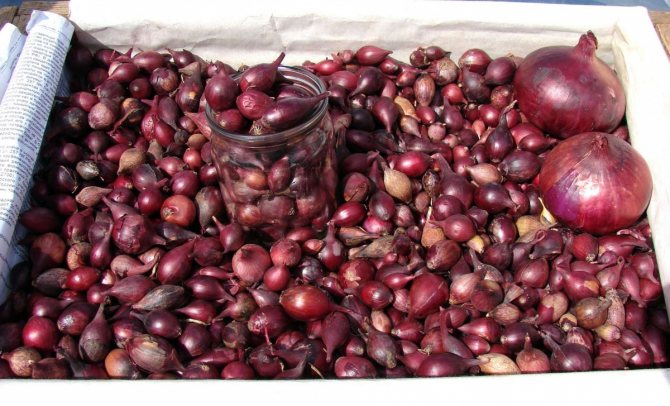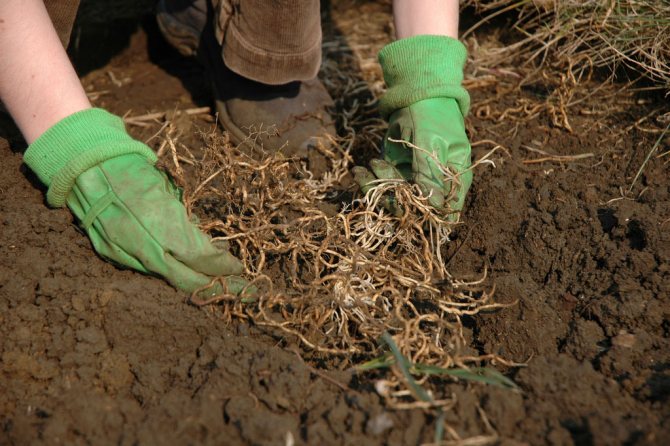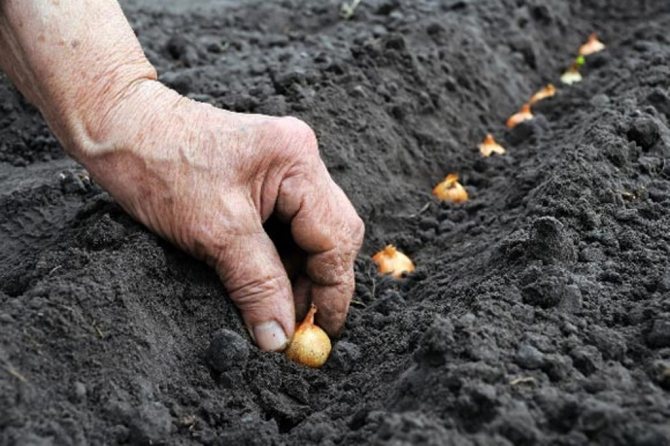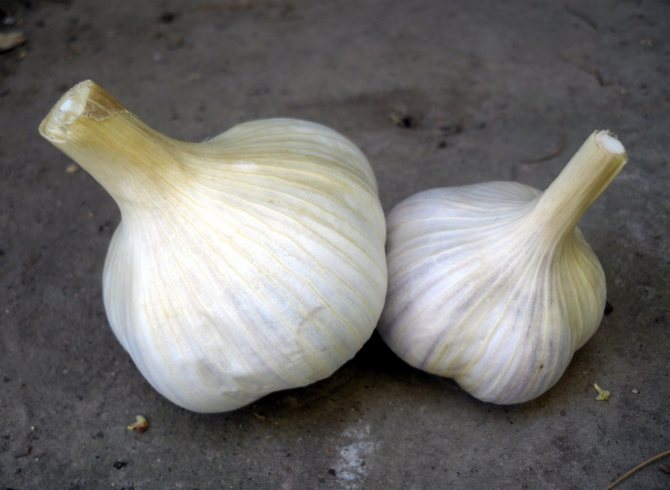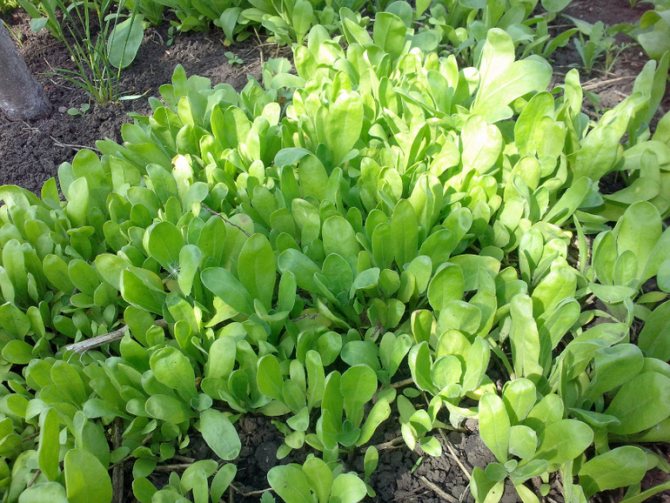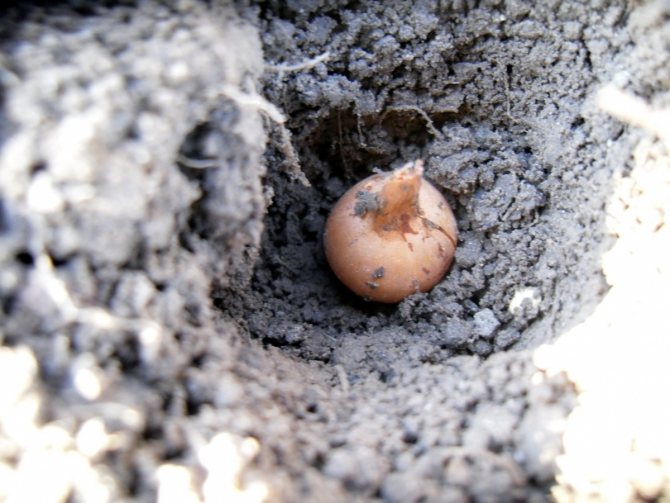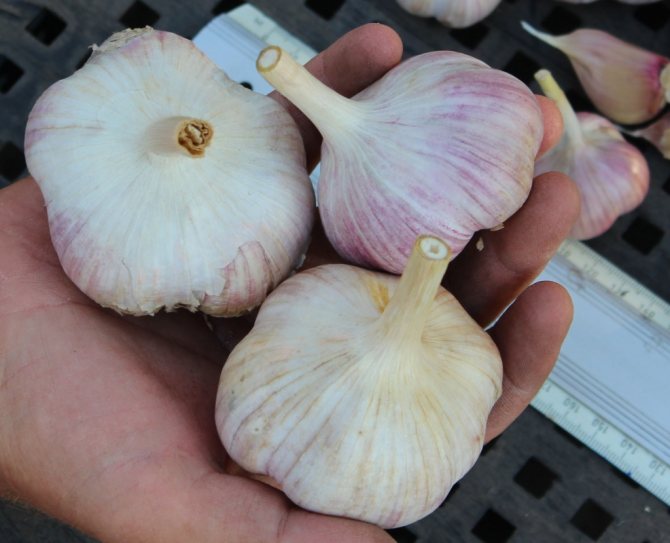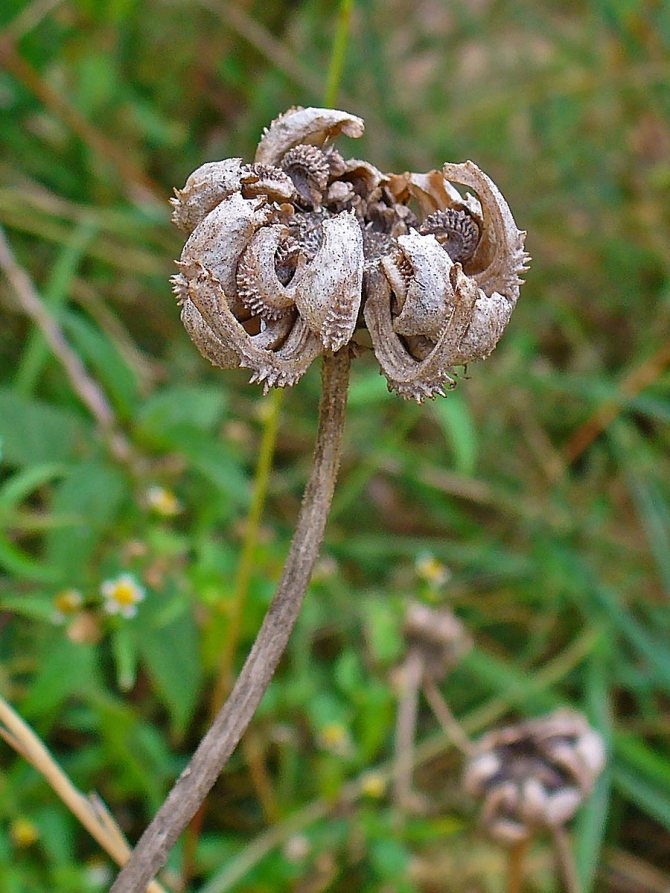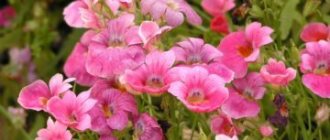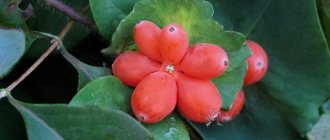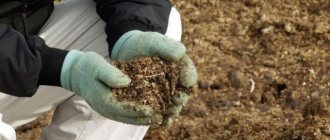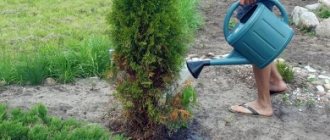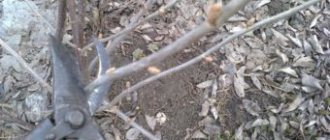The charming catchment is one of the most beloved shade-tolerant perennials. In the garden, touching aquilegia flowers with spurs seem to be fluttering fairies, then elven caps, shine with mystery and conquer with their grace. And although this is not the most spectacular of the blooming fashionistas, it is very reliable. And beautifully flowering varieties of aquilegia are able to surprise no less than their most catchy competitors. Whatever aquilegia we are talking about, the most popular and affordable way to multiply their collection is to grow plants from seeds, especially since there is nothing complicated in this process.
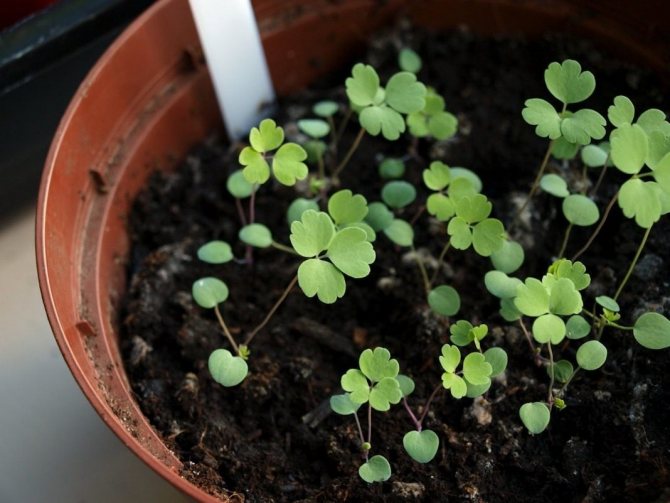
Seedlings of aquilegia.
Aquilegia (Aquilegia) is one of the most popular garden perennials. Despite the fact that the plant is mainly represented by various hybrid varieties and variety mixtures, and species aquilegia are considered very rare, seed propagation is the main method of propagation for all aquilegia. And although these plants can also be obtained using vegetative methods, it is easier, faster and much cheaper to obtain aquilegia from seeds.
By purchasing just a few bags or collecting seeds yourself, you can get enough full-fledged seedlings for any large ensemble in one "run".
Aquilegia is easy to recognize by the famous spur on the flowers, thanks to which the plant got its specific name. Touching flowers evoking a wide variety of associations with fairy-tale characters and spirits are a small masterpiece of nature that you never tire of admiring. Complex flowers on thin pedicels in loose inflorescences mysteriously and weightlessly gleam in the shaded areas of the garden, sparkling against the bright background of leaves.
Triple-complex, invariably bright in early spring, and in summer, and in autumn, the leaves seem to be an openwork and shining in the shade velvety background for quivering flowering. Simple or double, with a double perianth, the flowers of the catchment are ideally combined with bright leaves. Among the aquilegia there are plants that are undersized and taller, large-flowered and terry. You can choose them to your taste and for any decorative task.
Timing of winter landing
It is better to start sowing seeds of aquilegia in the second half of autumn, when the ground “cools down” to 2-4 ° C at depth. Depending on the region of cultivation, this can be October or even November. Planting earlier can help the seeds to sprout. This is completely useless, because young seedlings will not survive the winter, moreover, they simply will not live to see it. With the first good frosts, the plants will disappear. And if you sow, when it is already cool, the seeds will simply "go into hibernation." Having passed natural stratification, they will rise, as it should, with spring warmth.
Thanks to the natural cooling process, seedlings from seeds sown before winter turn out to be stronger.
When to sow seeds in the ground
Podzimny sowing significantly saves time on spring field work. But this process must be approached based on weather conditions. In different regions of our country, autumn and winter come at different times. In the north, in August, the first frosts already come, and in the south they can come in December, which is not at all typical for central Russia.
We will proceed from general points:
- After harvesting, you need to dig up the ground. Choose a period when the weather is dry, the soil will have time to dry out and will not stick to the shovel. In addition, seeds in such soil will be less susceptible to rot;
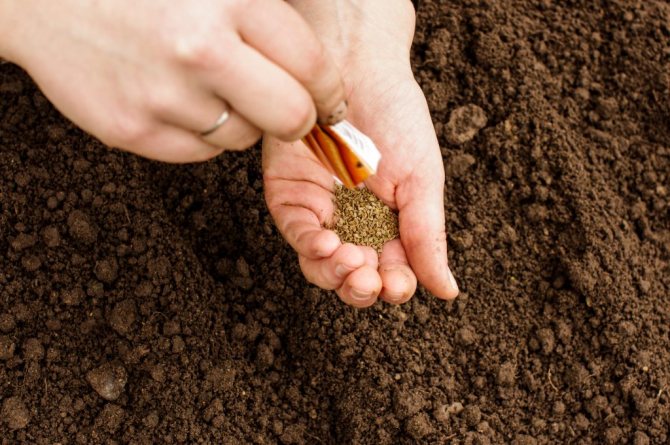

- The seeds sown should not germinate until spring. Therefore, the temperature outside the window should be no more than 0-2 C º. Seed material must be planted before the onset of frost, but in already cold ground;
- In regions with cold winters, crops with the onset of frost are covered with a layer of mulch or straw;
- Bulbous crops are sown in August-September, and seeds at the end of October. For the southern regions this period may be shifted one month later, and for the northern latitudes it may be one month shorter.
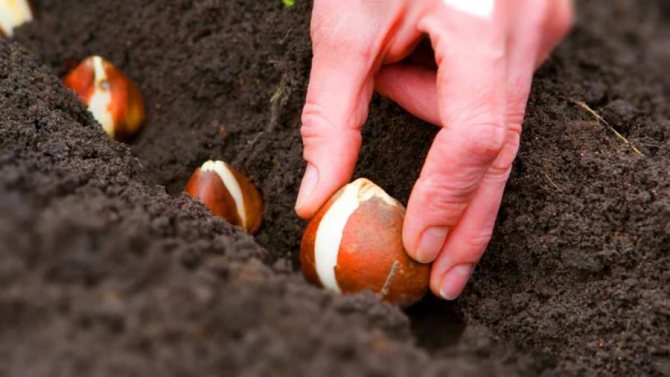

Winter sowing aquilegia - planting methods
For autumn planting, it is necessary to use dry seeds, without soaking and other preparatory treatments.
You can sow them in one of the ways to choose a florist:
- Wait until the first snow falls. Scrape it a little with your hands in the garden bed, but so that a snow layer remains on the ground. Scatter seeds over the snow - they are so clearly visible that it will help to avoid thickening of the crops. Pour a little earth on top, collected in advance, and then - with snow, which was collected from the flower bed.
- Before snow falls, sow directly into the soil. You can make grooves or just scatter the seeds, then cover them with a thin layer of soil.
- Sow especially valuable varietal specimens in pots with a light substrate, and only then dig in containers in the garden.
In the last two cases, crops should be covered before the first frosts. For this, a good mulching layer of fallen leaves or spunbond is suitable.
Sowing aquilegia in the winter allows not only to get healthier plants, but also to save time on spring troubles. At the end of spring, young bushes can be planted in a permanent place. And next year, aquilegia will delight the first flowering.
When and how to sow aquilegia before winter - video
Aquilegia is a beautiful perennial plant with colorful, vibrant flowers. These amazing flowers can be used to decorate flower beds near the house or in the garden, creating original compositions from lush bushes. Everyone can grow Aquilegia from seeds at home, the main thing is to provide the plant with proper care and optimal growing conditions.
What seeds to sow in autumn
Before winter, not all crops are sown; from a large list of vegetables, flowers, greens, they choose only those varietal species that are ready to endure the cold. Some of the planted plants can produce crops even under a layer of snow, such as spinach. The planted seeds undergo a hardening procedure before winter, and the strongest ones survive until spring.
what vegetables are sown before winter
Early vegetables and herbs from your garden are much healthier than store ones. As soon as the first snow melted, the first shoots of winter greens appear. Or rather, gardeners get their first harvest almost 3 weeks earlier than the usual spring sowing. As for the vegetables themselves, here it also turns out to win in 2 weeks. What's the first thing to see?
- Greens: cilantro, lettuce (leafy varieties are chosen here so that there are no root crops), parsley, sorrel, spinach, arugula, green onions (per feather), celery, cucumber herb;
- Onion and garlic: perhaps these are the most anticipated crops that are usually grown in the garden. Before winter, black onions, sevoks, varieties are chosen for sowing: Stuttgarten, Sturon, Carmen, Danilovsky, Strigunovsky. Among garlic, winter varieties are similarly selected, which are sown 1.5 months before the start of frost;
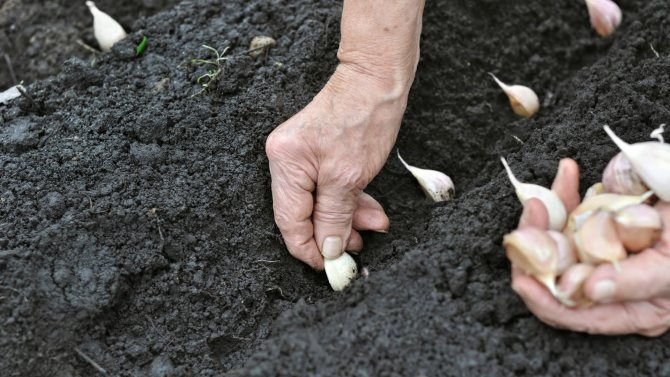

- Carrot: cold-resistant varieties are selected that tolerate shading well. Podwinter sowing is suitable for regions with mild winters. As a guideline for sowing, it is worth choosing a stable temperature of 2-3 ºC of heat. Among the frost-resistant varieties: Tushon, Samson, Shantane and others;
- Cabbage: among the abundance of varieties, it is advisable to choose late-ripening seeds. The fact is that when the first sprouts of cabbage appear, frosts are often held, which is detrimental to delicate leaves. They have to be covered with agrofibre, which requires additional labor costs;
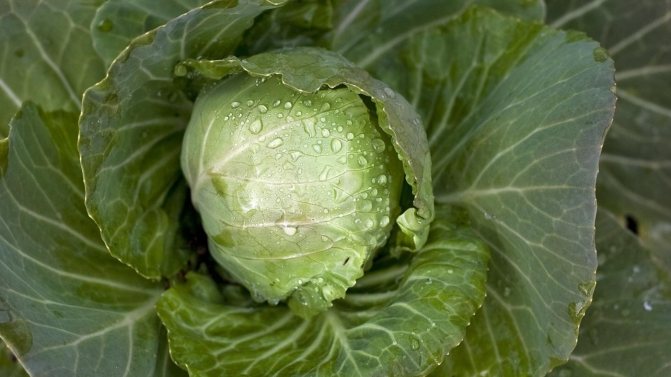

- Beet: It should be noted right away that beets have the same problem as carrots. When sowing in autumn, it is worth taking 50% more seeds, only the strongest are able to survive until spring. Among such materials, it is worth noting the variety Cold-resistant, Bordeaux and Podzimny. It is better to sow the rest of the varieties in the spring with the onset of a comfortable temperature;
- Radish: this vegetable has many varieties that tolerate winter well: Mokhovsky, Variant, Red giant, Soffit, Dungaysky and others. The reference point must be kept for winter hardiness. The main thing is to wait for a temperature of 1-0 ºC t. Among other things, parsnips, physalis, salad mustard are suitable for autumn sowing.
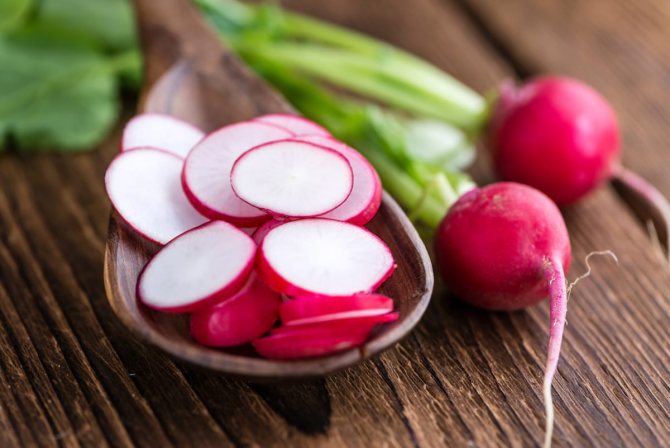

what flowers are sown before winter
Before winter, gardeners plant a lot of crops, including vegetables, herbs and even flowers. Moreover, both annual and perennial plants are ideal for planting. The stratification procedure is especially useful for perennial flowers. The fact is that when seeds are kept at low temperatures for a long time, the biomaterial gets a unique hardening. Such flowers are least susceptible to mold damage and have early shoots.
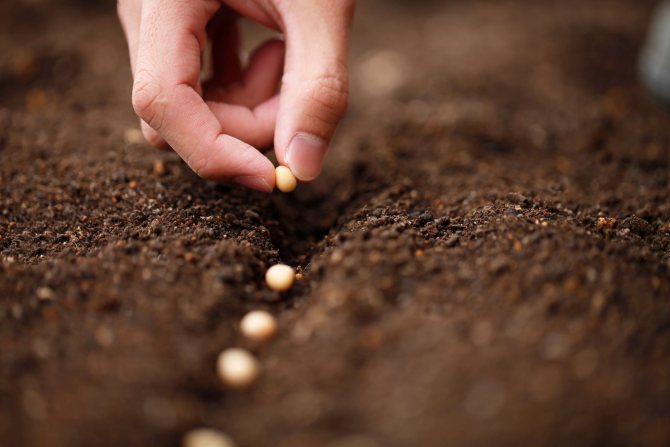

It is worth noting that flowers sown in autumn love humus-rich soils with a sufficient amount of water supply. In too watery soil, small flower seeds under the snow swim from row to row. Later, this will manifest itself at the first shoots, when a large number of flowers, concentrated in one place, sprout out of the ground. In order not to observe such a picture in the spring, it is recommended to add a certain amount of sand to the soil.
Here is a list of flowers that are sown before winter:
- Alyssum Marine - unlike vegetable crops, some flowers can, and even need, be planted in slightly frozen ground. As for alyssum, it is planted in a mixture with sand, because the seeds are very small. From above, the planting must be covered with a layer of mulch. According to a similar scheme, a similar culture of Lobularia is planted;
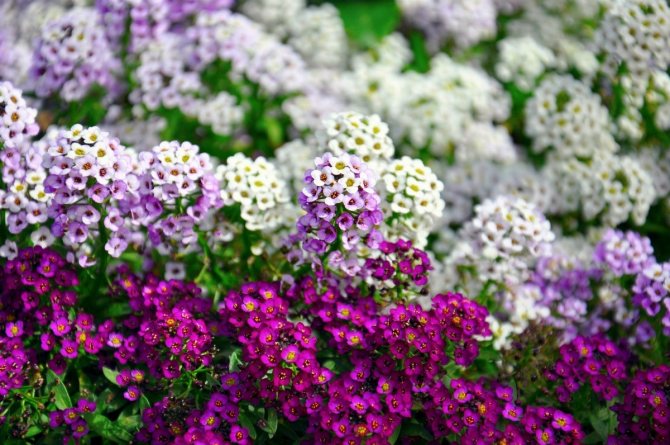

- Aster annual - this plant is quite demanding on the soil and the place of growth. Therefore, take care of this in advance. Flowers reveal their beauty in sunny areas with neutral and loose soil. Autumn crops sprout much earlier than spring crops, as soon as the bed warms up, green life begins to emerge in it;
- Marigold - These popular flowers love warmth. Therefore, immediately after planting, they are covered with a layer of peat, fallen leaves or straw. For the full preservation and maturation of seeds, a mild winter with early spring is required. Otherwise, the seeds will die in the cold and excess moisture;
- Godezia - a beautiful openwork flower is ideal for a personal plot. When sown before winter, the seeds of this plant have time to harden, which means that the flowering of these plants will be more magnificent;
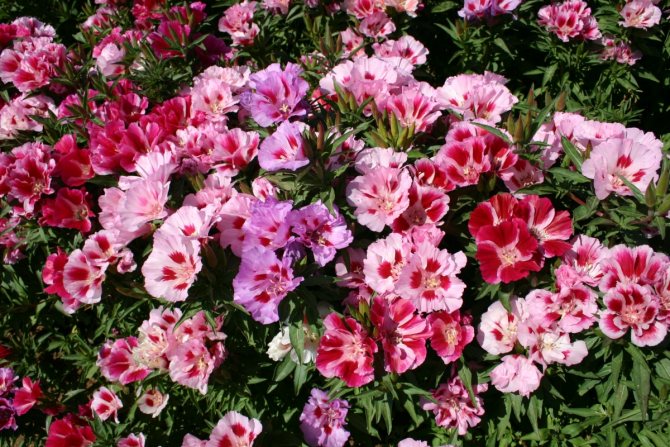

- Kosmeya - one of the most unpretentious plants, which pleases with its beauty from July to the very sunset of autumn. It is sowing before winter that shortens the germination period by almost a whole month;
- Wild rose or lavatera - the plant is good because it does not require special care. Therefore, many summer residents immediately sow it to a permanent place and forget about it until mid-summer. Closer to July, the plant acquires beautiful "bells" from white to pink-violet;
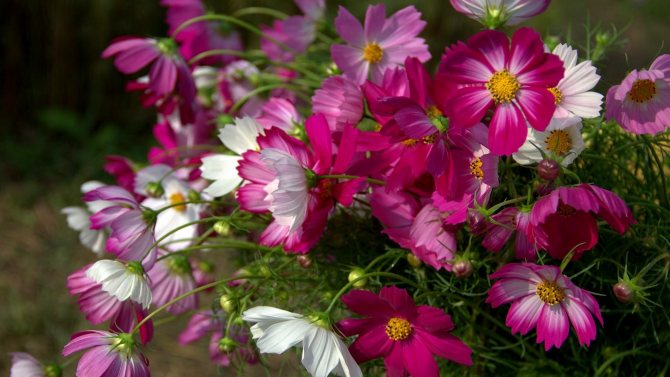

- Phlox - these flowers are loved because their seeds are not afraid of frost. In order to avoid premature germination, it is recommended to plant them after the first frost, when the temperature dropped to 0 º C. Top of the seedlings are covered with a layer of mulch or covered with agrofibre.
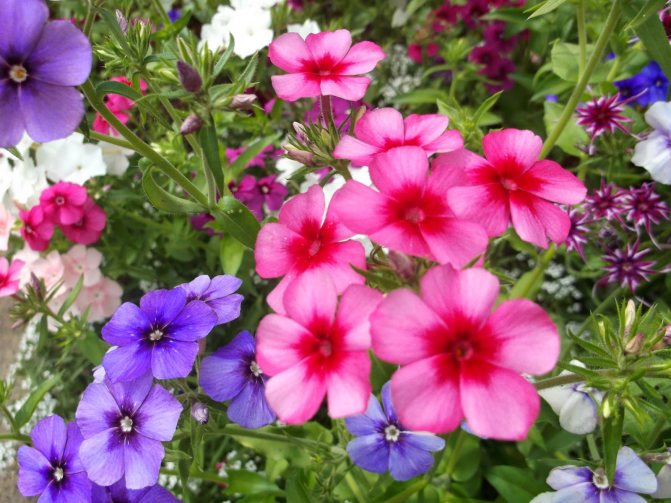

what perennials are sown with seeds
- Primrose;
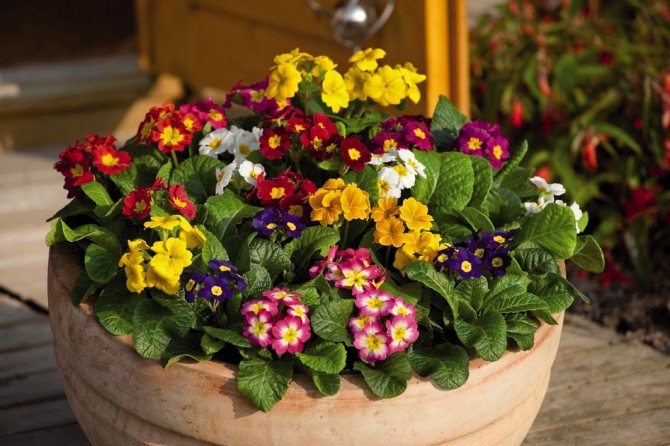

- Aquilegia;
- Delphinium;


- Forget-me-not;
- Lupine;


- Aconite;
- Alwood's Clove;
- Gypsophila;
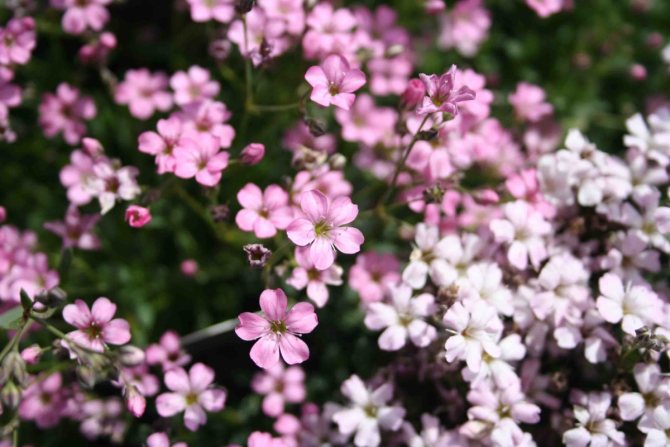

- Lavender;
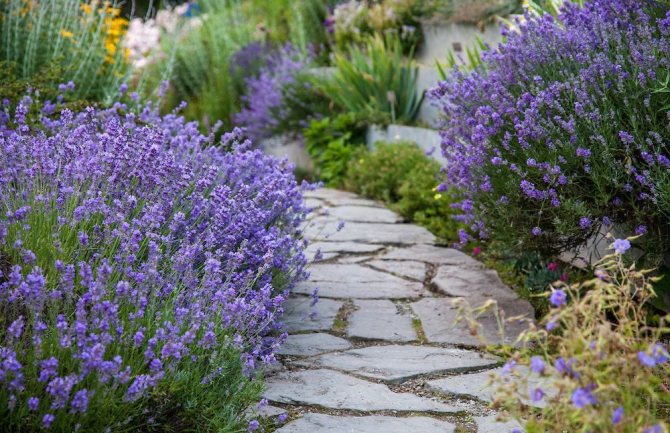

- Mallow.
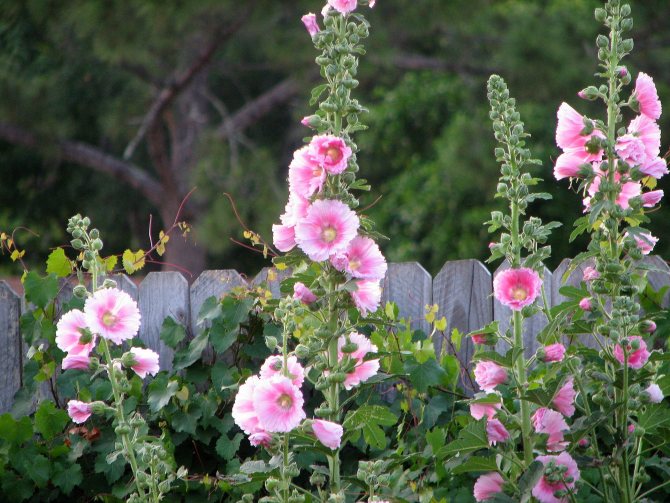

when to sow perennial seeds
Popular types and varieties of aquilegia
More than a hundred varieties of aquilegia have been bred, but only some of them are decoratively grown. The following types are especially popular:
Alpine... With proper plant care, the stems of this type of aquilegia grow up to 30-80 cm in height. The flowers of this variety grow quite large, up to 5-8 cm in diameter. There are spurs on the flowers - they are slightly curved and not very long. The color palette of this species includes various shades of blue.
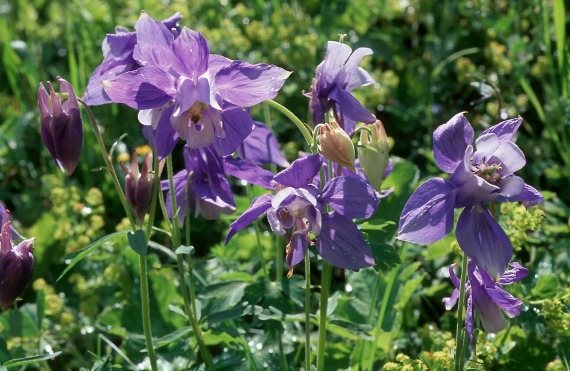

Alpine
Ordinary... Belongs to a European species, reaches a height of 40-80 cm. Flowers grow about 5 cm in diameter. Cultivars of this species come in various shades, but the most common are blue and purple. Flowers are available with or without spurs, simple and double. This species is resistant to severe frosts.
Fan-shaped... There is another name for this species - Akvilegia Akita. The plant's stems grow up to 60 cm in height, and the flowers are large - more than 5 cm in diameter. There are spurs on the flowers - they are rather long and slightly curved. Up to 5 large flowers can grow on one peduncle. The main shades of the variety are blue, pinkish, lilac-violet. Flowers have a fuzzy white border around the edges. This type of aquilegia reproduces very well by self-seeding.
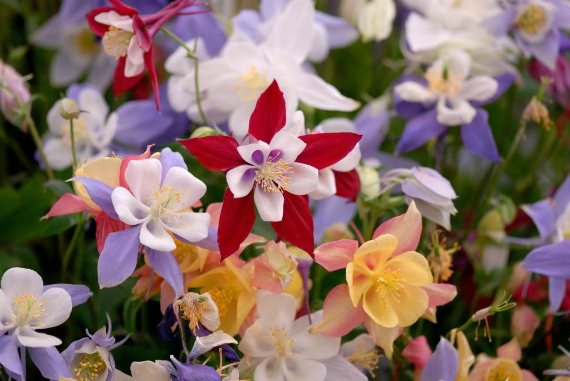

Canadian... Flowers of this species are red-yellow, with long spurs. This type of aquilegia grows well in the shade and loves moist soil.
Dark... Flowers are small - up to 4 cm in diameter, drooping, dark shades prevail. The spurs are small, but very nicely curved. This species begins to bloom in early summer. Grows well both in partial shade and in the shade. With insufficient watering, it can quickly wither in sunny areas.
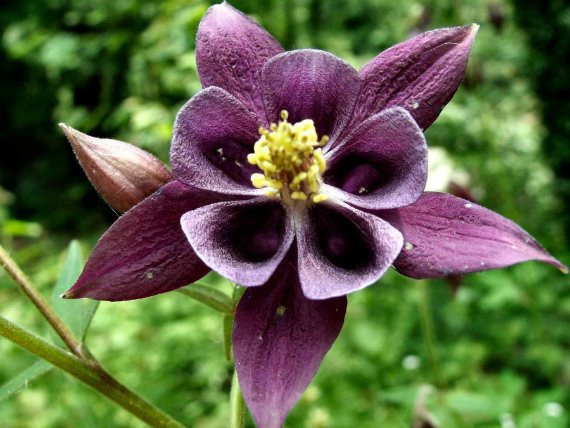

Aquilegia skinner... Flowers drooping, red-yellow, spurs are long, straight. This type of aquilegia is not afraid of frost. It tolerates even the most frosty winters.
Aquilegia golden-flowered... The flowers are large, with a golden tint and long spurs. It tolerates cold and dry weather well.
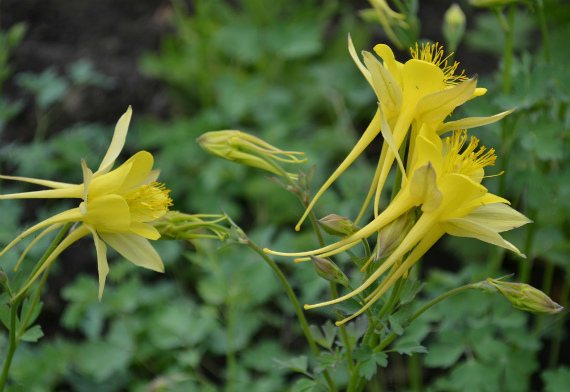

Aquilegia olympic... Height - 30-60 cm, stems are covered with dense fluff. The flowers are light blue, rather large, about 10 cm in diameter. There are long spurs. The flowering period is May-June.
In addition to these species, there are other varieties of aquilegia, for example, ferruginous, blue, small-flowered and two-colored, Siberian and others.
How to sow calendula in winter
Calendula grows best in sunlight in nutritious, loose, moist soil. Does not like extreme heat, blooms poorly in the shade. The flowerbed is prepared in advance, digging up the soil with fertilizers: half a bucket of humus and 20-25 g of potassium sulfate and superphosphate are added to 1 m2.
Blooming calendula will decorate any corner of the garden, so a flower bed or garden bed is prepared for it of the required size and shape
So that just before winter you can only pour the seeds into the ground and sprinkle them, when digging, part of the dry soil is stored, and planting holes or grooves are immediately prepared. Their depth is about 4 cm, and the distance between future plants is from 15 to 25 cm.
The more space the calendula gets, the more luxuriant it grows and the more beautiful it blooms, therefore, a 60 x 30 cm pattern is also used for decorative purposes.
So that the grooves do not collapse before sowing, you can temporarily cover the flower bed with foil. The seeds of calendula are large, they are not prepared for the autumn sowing in any way, they are sown dry. In the fall, sow twice as thick as required (excess seedlings are removed or transplanted in the spring). After spreading the seeds, sprinkle them with harvested dry soil. In cold regions, you can add mulch (humus, peat, straw), but usually nothing else needs to be done, but calmly wait for spring.
The seeds of calendula are so large that they can be easily decomposed one by one to the required place.
Calendula is an extremely easy flower to grow; even the most inexperienced summer residents do not have problems with it. If you sow its seeds at the very end of autumn, they will sprout in early spring, and by the very beginning of summer you can expect flowering.
When to sow aquilegia for seedlings


Growing aquilegia for seedlings can be done in containers or in the open field, and sowing can be carried out both in spring and autumn.
Spring sowing in seedling boxes is usually carried out in March, but preparatory work (stratification, scarification) begins a month before that - in late January-early February. And when 3 - 4 true leaves appear on the plants, they are transplanted into open ground.
For autumn sowing in open ground, stratification is not required. Aquilegia seeds can be sown on a temporary bed. When the seedlings appear and grow a little in the spring, they are transplanted directly to the flower bed.
When to plant calendula before winter
Calendula is a cold-resistant plant, its autumn planting does not carry any risk: in spring, seedlings can easily withstand frosts down to -5 ° C. But sowing seeds before winter is not too early: so that they do not have time to hatch in the fall, because in winter the seedlings will die.
The germination of calendula seeds is very good, and if they are sown early and often, they will sprout thickly, and will die during frosts.
Calendula can be sown when the average daily temperature is stable at about 0 ° C: a little warmer during the day, and mild frosts at night. Temperatures above 5 ° C are dangerous: under these conditions, the calendula begins to germinate. Therefore, they try to prepare the flower bed in advance, and sow at the latest dates, when it is still possible to work in the garden. In most regions, calendula is sown in November.
In principle, if the calendula is once sown on the site, there is no need to worry more about its availability. If you do not cut off a few flowers, the seeds ripen easily and the plant reproduces by self-sowing. Some of the seeds that have fallen into the ground germinate in the fall (these seedlings die by winter), the other successfully winters and sprout in the spring: all that remains is to plant them in the desired place. This is what I have been doing for decades.
After the end of flowering, many seeds are formed, which ripen well in most regions.
Growing aquilegia from seeds step by step
Before sowing seeds for seedlings, preparatory work is first carried out, and then the sowing itself is performed.
Preparation of soil and containers
Aquilegia loves light, moisture-free and moderately nutritious soil.
To grow aquilegia from seeds, you can use a universal mixture that is sold in specialized stores, or you can prepare it yourself.
You can use the following mixture options:
- sod land, leafy land, humus, river sand;
- sod land, humus, sand.
All components are taken in equal parts.
It is better to grow seedlings in tall boxes or containers so that the long roots of the plant can go deeper. But at first, seeds for seedlings can be planted in small containers (for example, plastic containers with lids). And in the future, it will be possible to transplant the seedlings into separate and already deeper containers (pots or cups), in which it will be necessary to make drainage holes.
About a day before planting the seeds, the substrate is poured into the container and slightly compacted. The soil is watered and allow excess liquid to drain.
Before sowing seeds, the soil must be sieved well to make it looser. This will help the seeds hatch quickly and easily. It is also necessary to disinfect the soil by spilling it with a fungicide or add phytosporin to the substrate.
Seed preparation
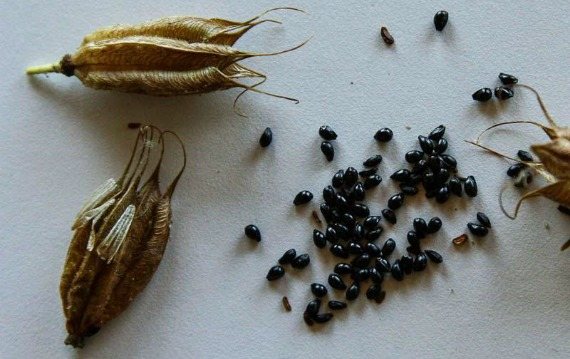

Aquilegia seeds are active only for one year, then their vital energy is significantly weakened. To provide yourself with good seed, you can use the following tips:
- the seeds are sown immediately after they are harvested;
- the collected seeds are stored in a cool dark place;
- a month before planting, stratification or scarification is performed;
- the seeds are treated with a solution of growth stimulants.
As mentioned above, during spring sowing, the seeds must be hardened. With the help of hardening, you can achieve more active and friendly seedlings. The inoculum is kept in a refrigerator (i.e. subjected to stratification) for 1-1.5 months, at a temperature of 0 + 5 ° C. The seeds are placed in wet sand or on moistened cotton pads.
You can also carry out scarification (exposure to heat) - the seed is kept for about 30 days at a temperature of + 34-36 ° C.
Important! Stratification or scarification improves seed germination. But this does not mean that without these agricultural techniques, nothing will germinate in you, especially if you do not doubt the quality of your seeds.
Sowing
Sowing aquilegia seeds for seedlings step by step:
- A container or box is filled with formula.
- The soil is well moistened with a spray bottle.
- Seeds are evenly distributed over the entire surface of the soil and sprinkled with earth by 0.5 cm.
- The plantings are moistened with a spray bottle.
- The container is covered with a lid (if a container is used) or covered with plastic wrap to create a greenhouse effect.
- Containers with landings are removed in a warm place. Aquilegia seeds germinate well at an air temperature of + 18-22 ° C.
When the first shoots hatch (somewhere in 10-14 days), the shelter is removed.
Advice! Since aquilegia seeds are very small, it is convenient to plant them with a toothpick, which must first be moistened with water.
Sowing aquilegia on snow - video
Planting Zinnia
Can be grown both with seedlings and directly plant seeds in open ground.
Landing in the open field
To make it easier for themselves, many growers sow Zinnia seeds directly into open ground.
You can plant seeds in open ground, bypassing the seedling procedure
When to plant
Seeds can be planted in early or late May, depending on the region and weather conditions. In warm sunny weather, the seeds germinate within a week, and if the crops are covered with lutrasil, this will increase the germination and germination rate of seeds.
With this sowing of seeds, seedlings hardening will not be needed when transplanting it to a permanent place.
Seed planting process
The garden bed prepared in the fall is once again dug up and well leveled. Zinnia seeds are sown in 5 cm increments. 10 cm are left between the rows. Everything is sprinkled on top with purchased soil, it is quite loose and nutritious, which will stimulate good seedling growth.
Water the crops carefully so as not to wash the seeds out of the soil and cover them with a film for better seed germination. On hot days, you will need to ventilate such a greenhouse so that the young seedlings do not get rid of the greenhouse conditions.
When 2-3 true leaves appear on the seedlings, it are seated in permanent places habitat, choosing sunny places in the flower bed.
For seedlings, it is important not to wash the seeds when watering
Basic requirements for outdoor care
In order for the seedlings to grow well and do not lack anything, appropriate care is needed for it.
Watering - should be carried out in the morning or evening hours every day with not a lot of warm water. Watering during the day in sunny weather will likely burn the young foliage of the seedlings.
When watering, try do not fall on sheet plates, as brown spots of leaf burn may appear under the film on wet places.
The temperature for good growth of seedlings should be at least 18-20 degrees Celsius. If the temperature is within these limits during the day, and drops at night, then a temporary shelter for the seedlings will be required for the night.
Zinnia does not tolerate sub-zero temperatures and completely blackens and dies.
If nitrogen fertilization was carried out during the preparation of the soil in the fall, then no more fertilization in spring... If the seeds are planted in unprepared soil, then when shoots appear, seedlings will need to be fertilized with full mineral fertilizer.
How and why to pinch, dive Zinnia
Seedlings should be pinched over the 6th leaf, if it will serve as a flower bed decoration. With this pruning, bushiness increases and there will be much more flowers. If grown on a cut, then pinching is not worth it.
Zinnia seedlings dive and seat in separate 200 gr. cups to increase the feeding area of each individual sprout.
When diving, deepen the seedling by 3 cm.
Diseases and pests
Sometimes, with improper care of Zinnias or due to unfavorable weather, the pet starts to get sick or is attacked by harmful insects.
If in wet weather amazes aphidto get rid of it, it is worth treating the flowers with Actellik's solution.
Snails and slugsthat eat Zinnia leaves during or after the rains are harvested by hand.
Most often, the plant can be seen powdery mildewthat appears during rainy summers.
Such diseases also appear:
It is sometimes necessary to inspect flowers in order to identify diseased specimens in time.
After flowering
The seed boxes ripen a couple of months after flowering. Therefore, in order to collect their own seeds, they choose the buds they like, mark the plant and remove all side shoots.
When the seed pod turns light brown, it is cut off, dried, taking out seeds and storing them in paper bags.
It will not be superfluous to sign the year of seed collection so the seeds retain their germination capacity for up to 4 years.
Features of winter care
The peculiarities are to remove the stem of the plant that is blackened from frost from the flower bed and prepare the flower bed for the next warm season.
How to plant from seed for seedlings
It is a real pleasure for the gardener to work with planting seeds of this type. Zinnia's seeds are large and have easy germination.
You can also make up the soil for seedlings yourself by taking:
The seeds are laid out at a distance of 5 cm from each other, if you plant them closer, then after a while you will need to pick the seedlings.
Before planting the seeds, soak them according to the instructions in Epin's solution.
Also for friendly seed germination cover the container with glass... And then, three weeks later, friendly shoots will appear, after which the glass is removed. Further care of the seedlings consists of:
- Watering.
- Loosening.
- Providing lots of sunshine.
Care "for seedlings
The growing seedlings of aquilegia need a fairly long day of light and moderate watering. Water it sparingly so as not to provoke the appearance of a "black leg".
Aquilegia develops a root system rather quickly, besides it has a very long taproot, therefore, if the seeds were sown in a shallow container, then when the seedlings have 2-3 true leaves (about 30 days after planting), it must be transplanted into deeper containers (with drainage holes).
Do a dive in the morning or evening. Immediately after transplanting, the plants are well watered. In the future, watering should also be moderate, as the top layer of the earth dries up. Every 10-14 days, seedlings are fed with complex fertilizers.
How to sow seeds before winter
Winter sowing of seeds can be carried out in a small school - a special bed, where all the comfortable conditions for the development of plants are created. Sowing in containers is also widespread, to prevent the plant from being washed off by melt water.
Sowing seeds in a school
The bed should be located in a southern elevated area. The optimal height of the school is 20 cm. With such a size of the beds, the possibility of washing out the plants with melt water is excluded, and the soil warms up faster.The soil begins to be prepared long before sowing from mid-September. The soil is deeply loosened, complex fertilizers enriched with minerals, potassium, phosphorus are applied. Coarse river sand with humus is added to clay soils, then the earth is leveled, compacted and grooves are made. The holes should vary in depth according to the size of the seeds. Small seeds are sown to a depth of 1 cm, medium - 2 cm, large - 4 cm. The school is covered with a film, since snow may fall before the seeds are sown. Seeds must be dried before sowing.
In late October - early November, you can start sowing. To do this, remove the film and place the seeds in several pieces in the holes. Large seeds are placed in smaller quantities in each hole, small in larger ones. You need to prepare the potting mix in advance. To do this, you need to mix humus, peat and sand. The wells are covered with prepared substrate. They collect fallen leaves, dried grass and cover the ground for insulation. No need to water.
In the spring, when the snow melts, the mulch is removed and the seedlings are waited for. When two true leaves appear, the plant needs to be thinned out as much as possible. After half a month, when the flowers get stronger, you need to remove the interfering shoots again. When weeding, it is recommended to carefully loosen the soil near the flowers without touching the roots.
Sowing seeds in a container
Before starting work in the garden, they stock up with suitable pots, prepare a soil mixture, coarse and fine sand, markings with the name of flowers, drainage.
Suitable containers for sowing before winter:
- The pots should be small, 7-10 cm.
- Drainage holes are required.
- Sowing containers should not bend easily, so as not to damage the root system of flowers, it is better to choose plastic or wooden cups with dense walls.
For winter sowing, it is recommended to use a special substrate. It should be loose enough for small roots to germinate and keep out moisture and air. To obtain a soil mixture, three parts of peat and sand and one part of earth are mixed. Before planting, you need to slightly moisten the substrate.
Expanded clay, small stones, small pieces of bricks are suitable for drainage. In order not to get tangled in the plants, markings are used. They are indicated by the name of the culture, the date of sowing.
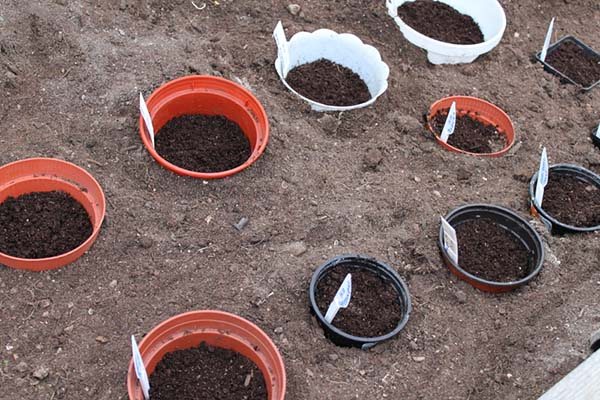

Sowing technology of seeds in a container:
- A drainage of 2 cm pours out at the bottom of the container.
- Then you need to pour the potting soil. There should be a distance of 2 cm between the substrate and the top of the pot.
- Slightly compact the substrate.
- The seeds are laid. Small seeds can be mixed with sand.
- Water containers with contents.
After the necessary preparation, you can start placing the containers in the garden. It is advisable to choose a place for future flowers that is well-lit, sheltered from the wind. Pits are dug to a depth of about 30 cm. Drainage is laid at the bottom, and containers are placed on top. The edges of the pots should be at ground level. The space between the containers is covered with dry grass and leaves. Then the pots placed in the trenches are closed with mulch.
Winter sowing is available to every flower lover.
When to plant aquilegia outdoors
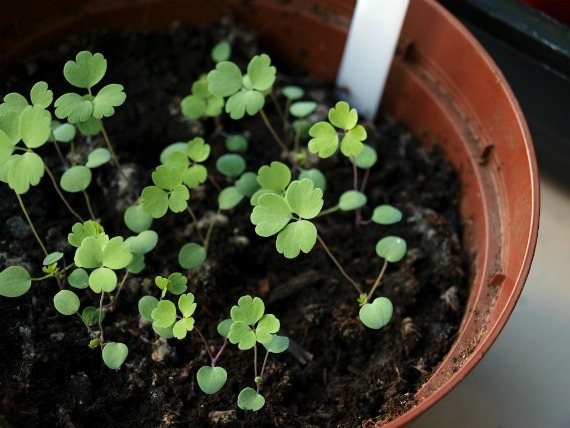

When the threat of recurrent frosts has passed, the plants are transplanted into open ground. This happens about a month after the pick (or two months after planting the seeds), by that time the seedlings will grow well and become strong. It is better not to rush with a transplant and wait until the air warms up to at least + 15 ° C.
Important! The plant can withstand a temperature drop of no more than +5 degrees.
Aquilegia is a rather unpretentious plant, it can be planted both in the sun and in partial shade, and even in the deep shade of garden trees or bushes, since it is shade-tolerant.
Planting aquilegia seedlings to a permanent place is as follows:
- Choose the most suitable place on the site in partial shade or shade;
- Wells are prepared according to the size of the container in which the seedlings grew;
- The planting container is spilled in advance so that the seedlings can be easily removed from it.
- The plants are carefully removed, placed in the holes, sprinkled with earth and pressed.
- Seedlings are planted at a distance of at least 30-35 cm from each other.
- The planted plants are well watered.
- The space between the plants and the ground around the stems are well mulched. You can use hardwood sawdust, hay, straw or dry peat as mulch. Mulch will help to retain moisture and prevent increased weed growth.
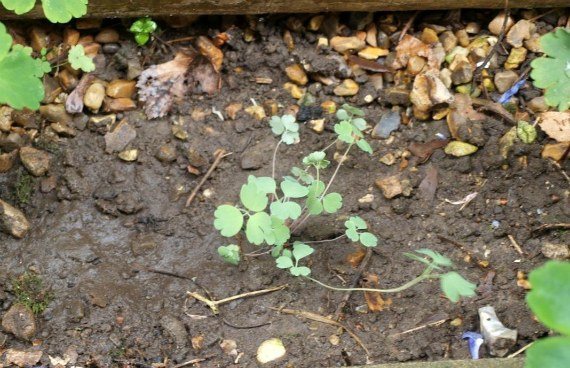

In the first year, a place protected from the wind and protected from direct sunlight is chosen for aquilegia, since young plants can simply burn out under the scorching sun.
Choosing a place for planting and care
Knowing the homeland of this flower, it is easy to guess that to grow zinnia, you need to choose the sunniest and most open place on the site.
In no case should you plant in a place where water can sometimes stagnate, or in a swampy area. It is a good idea to make drainage, which will rid the flower of excess water, and give it back when the plant needs it.
In general, the plant is unpretentious, needs moderate watering, loosening of the soil, timely removal of weeds. Faded buds must be removed if it is not planned to obtain seeds from them, because the flower spends its strength and nutrients on them, and the general decorative properties of zinnia are reduced.
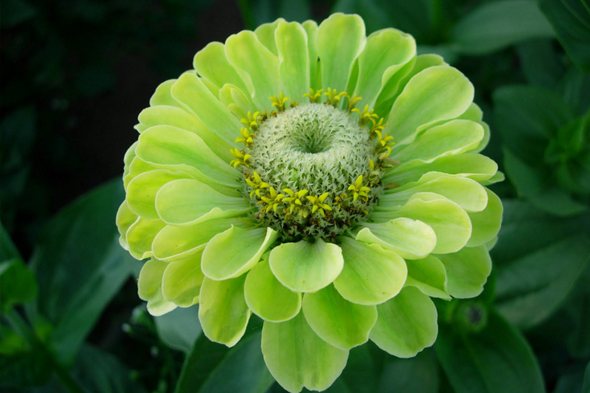

It responds well to feeding with organic and mineral fertilizers. The first application is carried out even before planting, as a rule, it is compost or humus. The second, a few weeks after planting, before the formation of buds, 0.5 tbsp is diluted with 5 liters of water. urea and 1 tbsp. organic fertilizer "Flower". They try to pour the composition at the root, avoiding contact with the leaves. The third feeding is carried out during the budding period - 0.5 tbsp each. fertilizers "Rainbow" and "Agricola for flowering plants" for 5 liters of water. During flowering, spray with "Bud", in the proportions indicated on the package.
How to properly care for aquilegia in summer
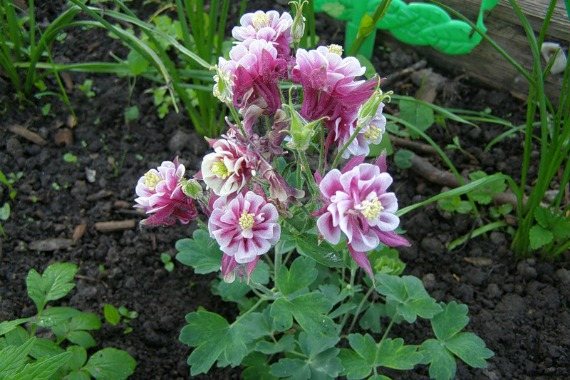

In the first year after planting, aquilegia does not bloom, all the forces of the plant are aimed at adapting in a new place and building up a powerful root system.
But already in the second year after planting - in late May-early June, you can enjoy the first flowers. In full force, aquilegia blooms only in the third year after planting.
Caring for a planted plant is reduced to the following procedures:
- Timely removal of weeds and loosening of the soil.
- Fertilization.
- Moderate soil moisture. The plant has a rather long central root, so it rarely suffers from a lack of moisture.
- Tying tall species. Plants are tied to wooden pegs with twine.
The roots of aquilegia, growing, often begin to stick out from the ground, they are sprinkled with rotted peat or just a new ball of soil. This procedure is carried out in spring and summer.
For lush flowering (2-3 weeks after planting), mineral fertilizers are applied:
- superphosphate -50-60 grams per 1 sq. m;
- potassium salt - 15-20 grams per 1 sq. m;
- saltpeter - 20-30 grams per 1 sq. m.
In summer, aquilegia is watered with organic fertilizers. Diluted manure and urea are used. You can also use ready-made complex fertilizers. This will help the plant gain more green mass.
Grown plants, which have been fed for 2-3 years already twice a season. In the spring, nitrogen fertilizers are used, and when buds appear, potash fertilizers.
Aquilegia refers to those plants in which it is necessary to remove dry (which have already faded) peduncles so that the plant does not waste its energy on planting seeds.
Growing methods
In countries with warm climates, zinnia is sown directly into the soil. In the conditions of the Moscow region, such an opportunity is issued too late, due to prolonged night frosts.Therefore, more often seeds are sown for seedlings, and then planted in open ground. It is important to choose the right time for sowing - overgrown seedlings take root very poorly and often die. Sowing is recommended in April. Seeds are tested for germination before planting. To do this, they are placed in a damp cloth. In new seeds, sprouts appear within 3 days, old ones can hatch even on day 10.
Zinnia seeds germination lasts for 3-4 years.
After selection, planting is carried out in a previously prepared soil, consisting of fertile soil and a mixture of sand and peat in a 1: 1 ratio. Since the growth is fast enough, the distance between the seeds should be at least 3.5 cm.The most suitable container for seedlings should have a height of 10 cm.The planting depth is no more than 1 cm.After that, the soil is moistened and covered with film or glass, until first shoots. They can be expected in a week.
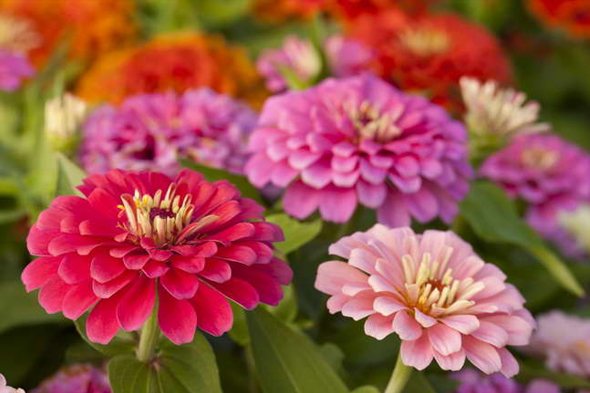

The soil should not dry out, but you should not pour the plants either. While the sprouts are small, it is necessary to irrigate them with a spray bottle to avoid damage. When the seedling reaches a height of 8-9 cm, a pick is made into individual cups. To form a powerful root system, it is recommended to pinch the main root at a level of 2 cm.
With the establishment of warm weather, the seedlings begin to harden. First for a few hours, then left on the balcony for the whole day. This will help to painlessly survive the landing in open ground, which can be started in late May - early June, as soon as the possibility of frost passes. The planting pattern depends on the variety of zinnia. For undersized plants, there is a sufficient distance between plants of about 20 cm, in the case when the bush is spreading - 40 cm or more.
You can sow zinnias directly into open ground, in mid-May, with seeds treated with a growth stimulant, but they will bloom, respectively, much later.
Aquilegia breeding methods
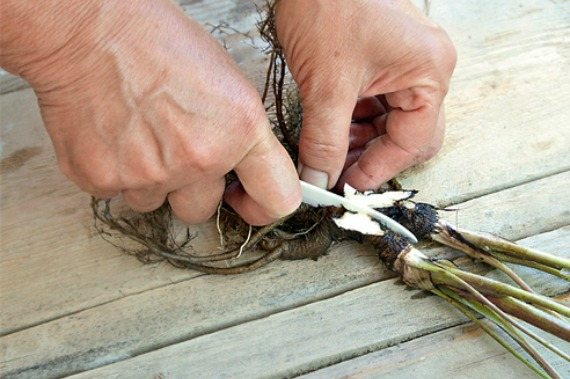

Aquilegia can be propagated not only by seeds, but also by cuttings and dividing the bush.
Cutting is considered the simplest method of plant propagation. Cuttings are harvested in the spring, long before the leaves begin to bloom. First, young and large shoots with internodes are cut off.
The section is treated with a growth stimulant. Shoots are planted directly in open ground, but you can first plant them in any container. Next, the stalk is covered with plastic wrap or a plastic bottle.
For the first 10 days, they do not remove the shelter in the plants at all, and then periodically ventilate (no more than half an hour a day) and moisten the ground. Cuttings are planted in loose soil with good drainage. When planting, coarsely granulated sand is added. When the cuttings adapt and take root, they are transplanted to a permanent growth site.
The method of dividing the bush is not used very often. It is used, as a rule, if there is a need to preserve a plant variety. Aquilegia roots grow deep enough into the ground, the plant is fragile and does not tolerate the division and transplantation procedure. The bush is divided in early spring, or in early September. For division, bushes are used that are more than 3 years old.
The procedure for dividing aquilegia is carried out as follows:
- The bushes of the plant are dug up, the roots are well cleaned of adhering earth.
- All stems are trimmed and leaves are removed completely.
- The root is divided into two equal parts. Be sure to have both healthy kidneys and strong roots on both sections.
- The place where the cut was made is well processed with crushed coal, and the cuttings are carefully planted in the ground prepared in advance.
- The land is well pressed and watered.
What are the benefits of calendula in the garden
The whole plant secretes phytoncides, which, if they do not destroy the pest, then scare it away. So, planting marigolds can cleanse strawberry beds from nematodes. Also, calendula in the garden helps against pests such as:
- bear,
- asparagus rattle fly,
- caterpillars of a hawk moth butterfly.
The green mass of the plant can be plowed into the soil, using it as a green manure. This operation heals the earth from late blight nightshade and nematodes. When growing calendula from seed for green manure, the best planting times are early spring and August.
In spring, calendula is sown on green mass before winter plantings of garlic, onions, carrots, and at the end of summer - to prepare the soil for the next season.
If you follow these simple recommendations, bright sunny calendula flowers will delight you all summer and will undoubtedly bring many benefits.
Calendula, otherwise - marigold, is a herbaceous plant that belongs to the aster. Western Europe, Asia and the Mediterranean - the place where calendula grows in the wild.
The name of the plant has Latin roots and in translation means the first day of the month. This genus includes about 20 species belonging to annuals.
At the same time, calendula varieties, in addition to exclusively decorative ones, include species with healing properties - medicinal marigolds.
Growing calendula does not present any difficulties, since the plant is unpretentious.
How and when to collect your seeds
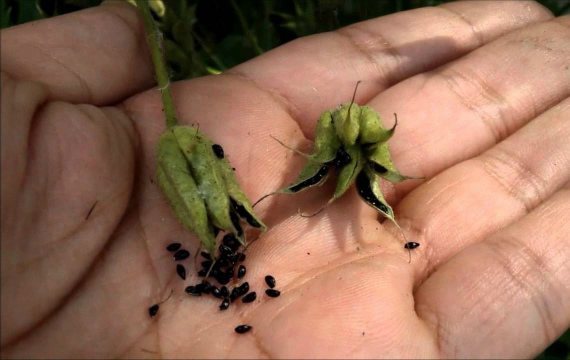

Aquilegia seeds are sold everywhere, and you can buy them at any flower shop, or you can collect them yourself from plants already growing on the site. If this plant is already growing in your garden or flowerbed, then the seeds for its propagation can be collected very simply. They are also stored well, and throughout the whole year they do not lose their qualities.
Aquilegia seeds begin to ripen in early August and are harvested as soon as the small green pods appear on the stems. If they are not collected in time, they begin to crumble to the ground. It is necessary to dry the seeds at room temperature, placing them on a saucer or on a napkin.
But you can also not collect the seeds, but leave them on the bushes, then self-sowing reproduction will turn out.
Self-collection of aquilegia seeds and their selection for sowing
If you want to collect seeds from aquilegia yourself, then it is better to plant varieties at a considerable distance, not to mix in compositions, since they are very easily pollinated and crossed. If you collect seeds in decorative compositions and flower beds, then you can control the varietal purity of aquilegia by preventing natural pollination - by tying gauze isolators and self-pollination of flowers with a brush (you need to rinse and dry it after each pollination).
The collection of aquilegia seeds is usually carried out in August, before they wake up (it is better to dry the seedlings in room conditions). With a slight pressure on the sides of the "boxes", the seeds easily wake up. Tying allows you to prevent this process. If it is not possible to sow seeds directly into the soil, then they are stored at a low temperature.
It is advisable to sow aquilegia seeds as fresh as possible. The seed life is limited, even after several months, the harvested seeds will need to be stratified. When buying aquilegia seeds, you need to carefully study the collection time and storage conditions, try not to buy seeds older than 1 year, even if you really like the varieties.
The maximum shelf life is 5 years, seeds older than 2 years are difficult to force to sprout, but with proper sowing, strong seedlings can be obtained from them. Aquilegia is popular and affordable, there are a lot of seeds on sale, you just need to choose a reliable manufacturer. It is better to select mixtures and varieties to your taste.
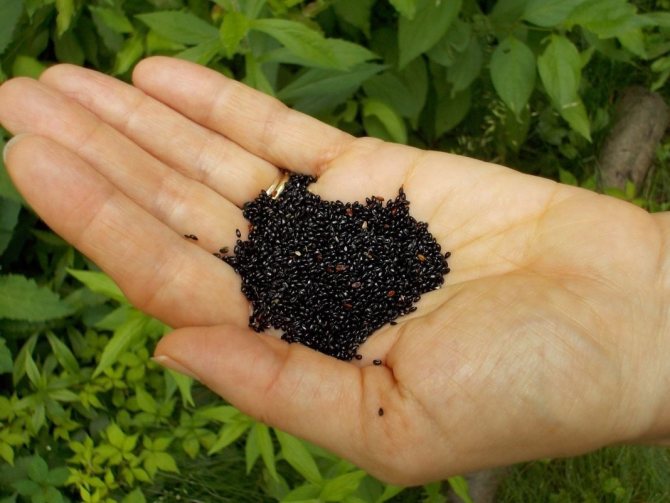

Aquilegia seeds. <>
Pruning the plant after flowering, preparing for winter
When the plant has faded, all peduncles are removed, since they have already lost their decorative beauty. Also, the entire bush is examined at the same time - dry and damaged leaves are removed. You can also cut off the entire ground part of the bush, because new stems will grow with the arrival of spring.
It is also very important to check the base of the flowers, in adult plants (over 3 years old), roots begin to peep out of the soil. So that the plant does not freeze in winter, all the roots protruding from the ground are covered with compost, previously mixed in equal proportion with manure. Such a shelter will protect the roots well from severe frosts and serve as an additional fertilizer.
With such a variety of aquilegia varieties, every grower will be able to choose a variety for himself that will decorate his plot with delightful flowers. You can choose several types of this plant and create a fabulous composition that will decorate a garden or a house plot.
Disadvantages, dangers, errors of pre-winter planting
Sometimes summer residents are indignant that nothing has grown from the autumn crops. The failure can be explained by the following reasons:
Poor seed quality. Often they use planting material that has lost its condition: expired, stored in improper conditions.
Failure to comply with sowing dates. Often sowing is already in the second half of October, guided by the advice of old publications, not taking into account the climate change that has occurred in recent years on the entire planet. As a result, the seeds have time to germinate before frost. Tiny delicate seedlings do not survive and die.
Wet beds. Summer residents in a hurry, after waiting for the first frost, are in a hurry with sowing. However, the earth still retains moisture, and after mulching it is warm. This promotes swelling and germination of seeds. The result is the death of seedlings.
Seeds are sown only 5–6 days after the onset of persistent cold weather. The moisture contained in the soil freezes during this time, the earth becomes dry.
Excessive burial of seeds. It is naive to believe that the embedment depth will protect them from freezing. Seeds of correctly selected flowers are not afraid of frost. But it will be difficult for fragile sprouts to break through, many will not have enough strength for this.
Post-sowing watering. Novice flower growers fear that their autumn labors will be in vain. The first skills of winter sowing can be obtained by sowing flowers, which are known for sure that self-sowing is their usual way of reproduction. These include marigolds, kosmeya, echinacea, rudbeckia, as well as garden crops of rare vitality - coriander, dill, parsley.
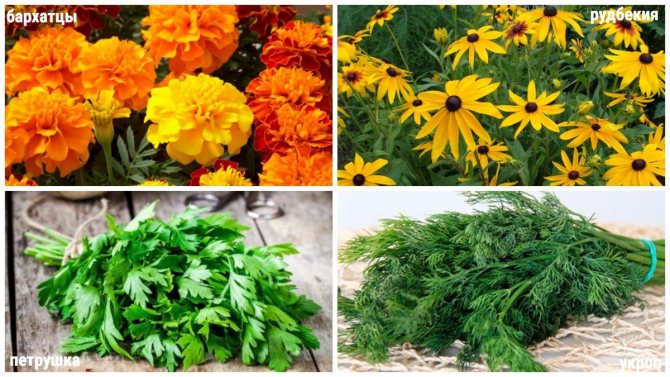

The correct choice of beautiful flowers for winter sowing, carrying out the process according to the rules described above is a guarantee of early blooming of garden pets that decorate life and attract bees.
Aquilegia in landscape design - photo
Aquilegia yellow
How to prepare the beds for winter sowing of vegetables
The preparation of the ridges plays an important role in the process of winter sowing. After all, only high-quality, reliably protected beds with nutritious soil can become worthy protection for seeds that have to endure the winter in the open air.
For sowing vegetables, it would be better to choose high beds, but if you are not a supporter of their arrangement, ordinary beds are also suitable, reliably protected around the perimeter by boards, slate, polycarbonate or other material. Such a fence will not allow the spring waters to wash away crops and retain snow on the ridges.
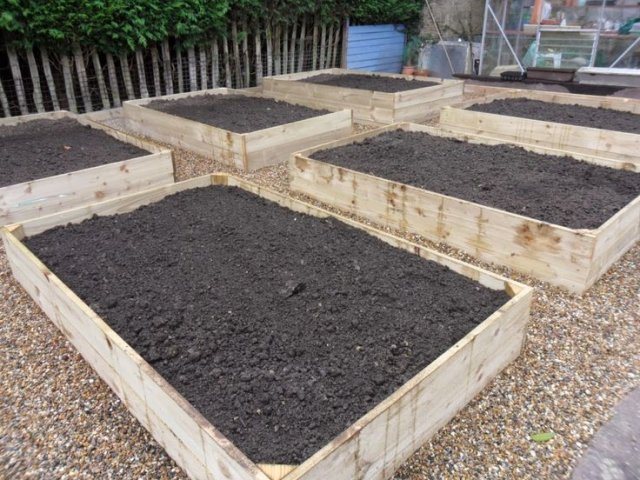

Place your plantings on the sunniest and most elevated place, where the snow melts in the spring. However, if you have such a place in an open space, take care of windproof structures, for example, install shields on the windward side. If there is already little snow in your area, do not forget to prepare in advance a layer of spruce branches or other mulch, which will replace the snow layer in your beds.
As with sowing flowers for the winter, the ridges need to be prepared in advance, while the temperature is above zero. Weed the soil, apply fertilizers with a low nitrogen content (AVA, Autumn, diammofosk, nitrophoska), draw with a plane cutter or rake angle the seed furrows 3-5 cm deep, and then cover the ridge with foil to avoid waterlogging.In separate bags, stock up the substrate for mulching plantings (garden soil with peat and sand in a ratio of 1: 2: 1), and wait for frost.


When a stable negative temperature is established, sow seeds 1.5-2 times more than the norm, cover them with prepared soil, and then mulch with spruce branches, spunbond or healthy leaf litter. The thickness of the shelter should be about 15 cm, but remember that light leaves can be blown around the area by the wind, so they need to be fixed.
There is no need to water the autumn crops - the spring melting snow will be enough to water the seeds with moisture.
Aquilegia: growing from seeds and care - video
The main thing when caring for both young seedlings and adult plants is to remember that this flower does not like excesses. Not very bright lighting and moderately moist soil are ideal for aquilegia. By adhering to this rule, you can always grow beautiful and healthy plants in your garden.
Today we will again pay attention to such an unpretentious garden flower as aquilegia (growing from seeds, when planting seedlings at home). After all, the creation of flower beds in a summer cottage or a personal plot is an exciting activity. And today we are surrounded by many varieties and types of flowers, and it is often very difficult to choose what is suitable for a given flower bed or flower garden. One of the rather unpretentious and surprisingly beautiful flowers is aquilegia, or, as it is also called by the people, the catchment.
Why gardeners love calendula
Low varieties up to 30 cm in height grow well on the balcony and in outdoor pots in the company of petunias, ageratum, bacopa. Tall members of the species (70-80 cm) are good for the background.
Gardeners like the "early ripening" calendula: growing from germination to flowering takes 1.5-2 months. Cold resistance allows sowing it early: 2-4⁰C is enough for seed germination, small frosts are not terrible for seedlings. And already in early to mid-June the first bright baskets appear.
Caring for marigolds is simple: weeding, loosening the soil, fertilizing with fertilizers in spring and in the first half of summer, along with other flowers.
The plant gives excellent self-seeding - the seeds scatter around the site and germinate spontaneously: leave next year where necessary or weed out. So as soon as you plant calendula once, it will always sprout in the same place by self-sowing.
Calendula is unpretentious to the substrate - neutral, slightly acidic soils with a PH of 6.5-7 are suitable for it. Despite its southern origin, the species adapts plastically to a range of climatic conditions from Crimea to St. Petersburg.
All these qualities of the plant are attractive for arranging a garden landscape in a "rustic style". So, the mixture of seeds of the "Mauritanian" lawn includes flax, resin, annual poppies and calendula: growing an unpretentious flowering meadow is one of the steps to a garden of minimal maintenance.
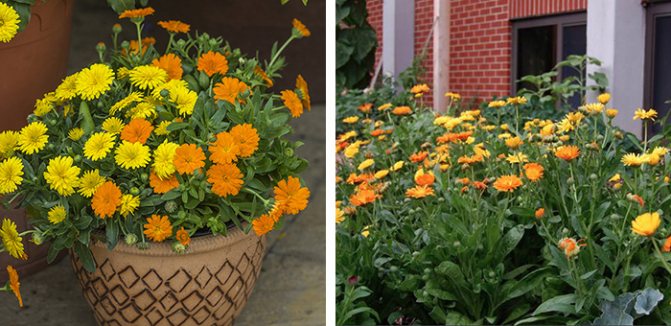

Calendula is equally effective in containers and garden plantings
How to plant aquilegia from seeds at home or directly into the ground
Aquilegia is a perennial plant whose flowering begins as early as the second year after planting in the soil. As we said earlier, there is a wide variety of shapes and inflorescences, however, aquilegia always blooms with amazing complex, double flowers, and looks great on any flower bed, and in landscape design too. The catchment area grows in general on any soils, but best of all, its flowering occurs on loose, moist loams. Shade or partial shade is also preferable for this flower, so planting in any shaded areas is not a problem. Aquilegia is propagated in different ways - by cuttings, dividing, seeds. But the last option - it turns out in the end more simple, cheaper and preferable, and we will consider it.
Diseases and pests
The greatest danger to zinnias is the fungal disease gray rot. It spreads very quickly to the plant.You can recognize it by its characteristic brown bloom on the leaves and stem. In advanced cases, mold can cover the entire plant, including the flowers. At the first manifestations of the disease, the affected leaves are removed, the plant is treated with special preparations against gray rot.
Powdery mildew often appears in rainy and rainy years, due to an excess of moisture in the soil. It is manifested by the appearance on the leaves of a gray coating, similar to dust.
You can distinguish black spot by the brown spots formed on the leaves with black blotches - spores. Infected plants must be removed, healthy plants must be sprayed with Bordeaux mixture.
Beautiful flowers can also damage insects, more often aphids, caterpillars, ticks, snails, spider mites, less often May beetles eat zinnias. If found, they must be removed, the plants are treated with insecticides.
Preparing the soil before planting flower seeds
We learned what kind of flowers are planted by seed. And how to do it correctly? It is always better to prepare the soil for sowing seeds in the fall. Dig it to the depth of a shovel bayonet, fertilize with thoroughly mixed manure and compost. Try not to overdo it with the amount of fertilizer, especially if you plan to plant annual plants - they do not bloom very well in too nutritious soil.
If we are talking about spring planting, with the arrival of early spring, the soil should be well leveled with a rake until all earth clods are broken. If the soil in your area is too light, compact it. Don't overdo it! In too dense soil, the seeds are unlikely to be comfortable.
Note: if you want to decorate ridges and borders with flowering plants, you do not need to prepare the soil for sowing.
However, in the case of large flower beds, it is better to spend a little time planning them. Consider not only the varieties of plants, but also the combination of their colors, shapes and even height.
The easiest way to make grooves is to use the side of a hoe or a rake. You can pre-outline future grooves with thin streams of sand.
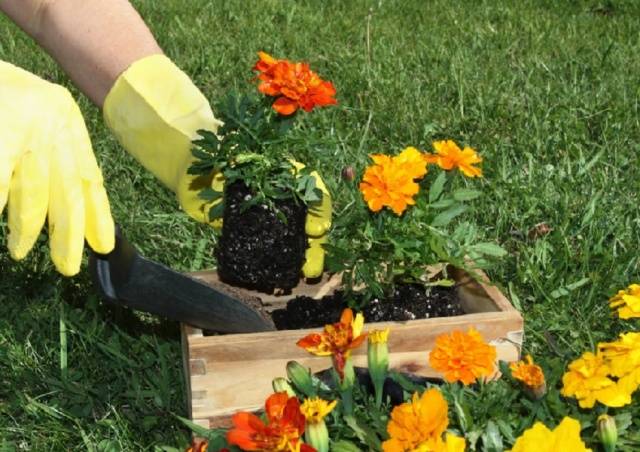

After sowing, the seeds are carefully sprinkled with soil. This can also be done with the side of the rake, with your hands or even with your foot - that part of it that football players call the “cheek”. Just proceed as carefully as possible.
Remember that birds look forward to eating seeds. To deprive them of this pleasure, cover the beds with spruce branches. Dry branches are fine too. And the stretched black fibrous material with pieces of foil between the fibers will scare away not only birds, but also cats.
In dry weather, remember to water your plantings. As soon as the shoots hatch, remove the shelter. If the planting is thickened, thin it out, otherwise the plants will simply not have enough food.
People are used to the fact that spring is the time to plant vegetables and fruits, as well as various flowers and greens. But so that in the spring the garden plot pleases the eye with beautiful flowers, they can be planted in the fall. True, each flower has its own planting characteristics, so you need to know which varieties are planted for the winter.
What is planted in the fall in the country
Seeds sown in the fall allow plants to bloom one to two weeks earlier. In addition, in the spring there will be less hassle with seedlings. It is better to immediately plant the seeds in the flowerbed and then not transplant. In the fall, any seeds are sown thicker, given that not all seedlings will survive. If the plants are too thick in spring, they can be thinned out.
As for perennial plants, it is better to sow them in the fall anyway. For seed germination of many perennial species, it is required cold stratification... Such plants that require stratification include primrose, lavender, delphinium and others. Most of the perennials sown in spring will bloom the next year. If you plant the seeds of perennials in the fall, and cover them with foil in the spring, then very often the plants bloom by the end of summer.
Why should flowers be planted in the fall?
It may seem to many that after a hot summer and harvesting in the autumn, the earth should rest, and it is better not to plant anything in it for the winter. However, for plants, this process has a number of advantages.
First, the plants are hardened. This is due to the fact that the strongest seeds survive in the winter soil, so in the spring they will show good shoots, will have immunity to various diseases and pests.
Secondly, plants already hardened over the winter will not be threatened by spring frosts. Such plants are able to quickly form a root system, which can absorb moisture from the soil for good growth.
It is very important that in the spring the owners do not have to worry about the temperature of the soil and air suitable for planting, because only the strongest and most resistant plants will appear during this period.
For autumn sowing, you need to choose those annuals that are immune to cold weather. It is better to plant them in frozen ground, since warm soil will be perceived by the seeds as if planting was done in a warm spring. In this case, the plants will germinate earlier, which will lead to their death.
The landing site is of great importance. It should not be under the scorching sun rays, especially if there is no snow for a long time in winter. Also, the site should not be located where melt water flows in spring, since the seeds will quickly be washed out, and there will be no harvest. During planting, you need to monitor the density of the seeds. This figure should be higher than in the spring.
It is recommended to start preparing the land in September. Preparation consists in digging up the soil, fertilizing it and making beds. If the seeds are very small, the depth should be 1 cm, if large - about 5 cm.
The land remains in this state until the end of November, and when it is already completely frozen, you can sow seeds densely in the beds, add humus or peat mixed with sand there. When the flowers already have several leaves in the spring, the beds can be thinned out so that in the future the plants have the opportunity to develop well.
Flowers that grow for one year, which can be planted for the winter, include medicinal calendula, fragrant mignonette, keeled chrysanthemum, snapdragon, Chinese aster and carnation, and some others.
Such flowers give even better yields than annuals, so it is very useful to plant them in the fall. True, the choice of perennials must be taken very seriously, since they quickly germinate and harden, but give color only after a few years. If there is no desire or opportunity to wait for the harvest for so long, the variety of flowers should be express, that is, one that blooms already next spring.
It is recommended to plant perennial flowers when the soil freezes only a little, that is, somewhere after the end of October. The planting principle is similar to how annual plants are planted. At the same time, it is very important to compact the earth a little, thus protecting them from various pests.
When the snow leaves with the onset of spring, it is recommended to cover the area with flowers planted in autumn with a film, which is removed after the first shoots appear. If the flower already has about 4 leaves, the flowers need to be dived so that the root system is strengthened.
Among the perennial flowers that need planting in autumn, it is worth highlighting bells, alpine aster, aquilegia, euphorbia, oriental poppy, lupine and others.
If a flower grows from a bulb and gives color in spring, it should be planted in early September. Of course, it is important to take into account the geographical location of the site, the climate in a particular area. The main thing is that the seating takes place a month before the first frost.
Since the plants that sprout from the bulbs primarily bloom in the spring, it is better to place them in open areas. Such flowers are also called primroses, they include hyacinths, tulips, daffodils, anemones, primroses, irises.
By the way, the bulbs of the latter must be distributed at the beginning of September, sprinkling with ash before planting them in the soil. The same goes for peonies. Regarding seeds, it is better to prepare poppy, liatris, foxglove for autumn sowing.
Summer shoots
Flowers that delight with their color in summer can be planted shortly before frost. For example, a lily bulb is a good option and needs to be replanted every few years. Flowers growing from seeds are chamomile, lavender, delphinium and others.
Whatever flowers are planted for the winter, it is very important to prepare the ground in time, dig it up, apply fertilizers and the necessary vitamins. The best period for this is September.
Planting annual and perennial flowers before winter has many advantages. The seeds are well hardened, and in the spring they give high-quality shoots, which are distinguished by good growth, and are resistant to frost and disease.
Time is fleeting, only it was spring, and you look already and autumn is just around the corner. Before you have time to look back, it's October, rainy November, and there are frosts and winter. Everything in the dacha freezes until the new spring, and garden work, it would seem, has long been stopped. But it seems so only at first glance.
In the fall and even at the beginning of winter, you can sow flower seeds. Planting before winter has many advantages over spring sowing. If you have never experienced this, I advise you to take a closer look at the idea.
It only seems to us that flower seeds are defenseless and are destroyed by frost. They have a program of adaptation to any conditions, and germination in any moist hole, as soon as the earth warms up enough from the spring sun.
Planting rules
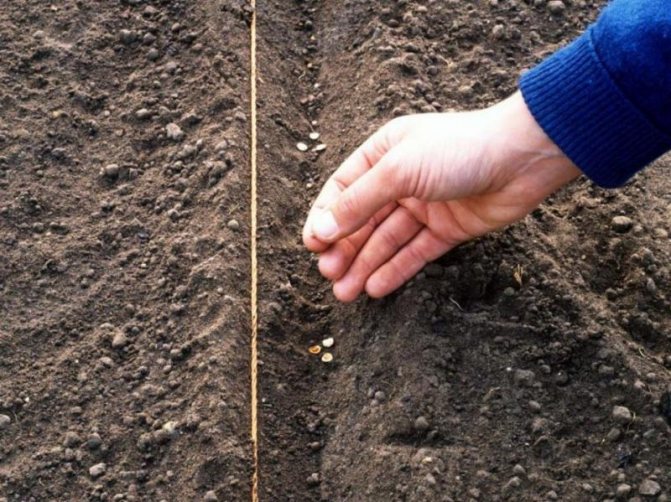

Seeds must be dry
When a stable minus temperature is established, sowing begins. Although some summer residents practice exactly winter sowing (January, February). This is possible in areas where the instability of autumn weather can cause early germination of seeds. But it will be necessary to stock up on soil with which the frozen holes will be sprinkled.
For the south, this method is used for planting in the winter months (January or February), when the ground begins to thaw, but not yet warmed up to such an extent that the seeds begin to grow.
The number of seeds is taken twice as much. They must be dry. Above the holes, the ground is slightly compacted. This will improve the adherence of the seeds to the soil. Then everything is covered with mulch to insulate the sown material. The coating layer must be at least 15 cm.
If foliage is taken as a covering material, it must be fixed so as not to be blown across the territory by the wind. If a little snow falls during the winter, you will need to throw more snow on the ridge yourself.
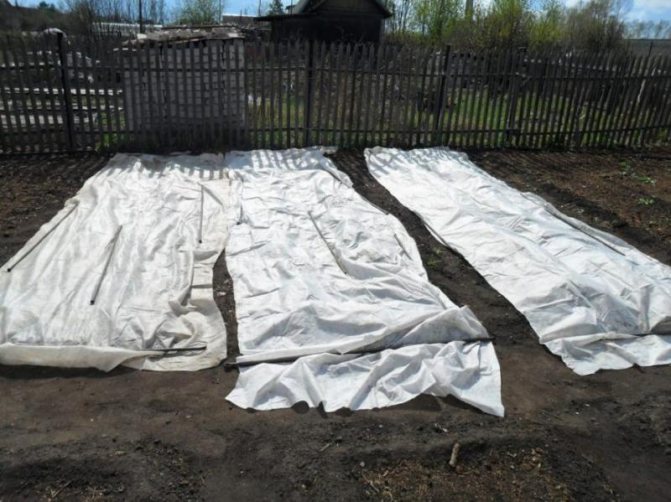

Beds under agrofibre
Watering for autumn planting is not required, since moisture from melt water for seeds will be in excess.
In early spring, the ridges are covered with polyethylene, which is stretched over prepared wire arches. This will give the soil an opportunity to warm up, which will affect the acceleration of germination and development of the sown material, and will also protect if frosts return.
Let us consider in more detail the necessary conditions for planting on the example of each individual crop.
Cabbage
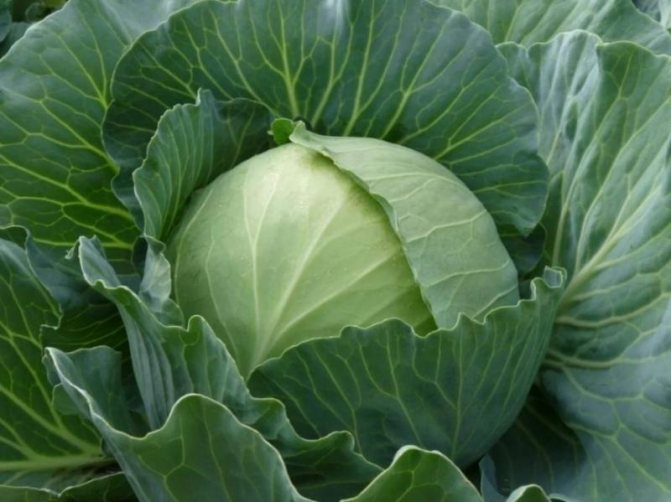

Cabbage
Cabbage
In practice, the culture is rarely planted before winter, because she needs a warm climate. Although for the southern regions it is also a risk. Seedlings appear quite quickly and, if the weather is unstable in spring, there is a high probability that they may freeze.
When deciding to plant cabbage before winter, it is necessary to choose only the recommended varieties.
The recommended seed depth is from 1.5 cm to 3 cm.
Sowing volume - up to 0.2 g / m2.
Potatoes
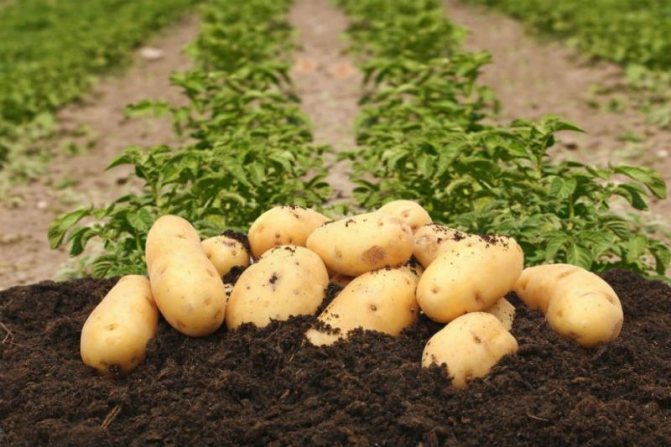

Potatoes
Potatoes
Usually potatoes are not planted during the winter. But when the tubers are buried by 10-15 cm, they are able to perfectly tolerate low temperatures down to -100C. The mass of the potato should be about 100-150 g.
Landing takes place without vernalization during the period when frosts begin at night and the temperature rises during the day. The soil has the ability to thaw.
For planting a culture, double ridges are used. This allows wire arches to be placed above the rows in the spring season. Planted in a checkerboard pattern.
The recommended fruit depth is 15-20 cm.
Recommended parameters:
| Bed width, cm | The gap between the ridges, cm | Gap between rows, cm | Gap between fruits, cm |
| 70 | 80 | 45 | 25-30 |
Onion
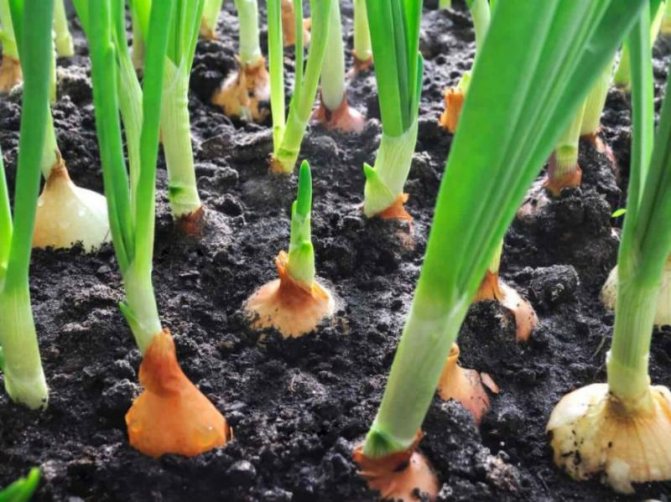

Onion
1
The tramp can be planted three times per period. Winter sowing is considered the simplest.
The recommended depth of the material is from 2 cm to 2.5 cm.
Sowing rate - 6-8 g / m2.
Recommended parameters:
| Spacing between cultures, cm | Gap between rows, cm |
| 20-25 | 40-50 |
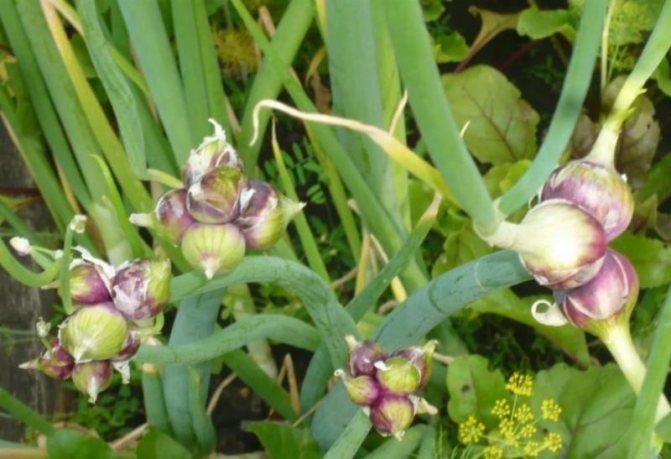

Tiered bow
2
A multi-tiered bow is not afraid of low temperatures down to -400C. But there is one caveat - by the winter period, the culture should have formed good roots. The bulbs are planted in 14 days. before the onset of frost in 2-3 lines.
The recommended depth of the bulb is 3-4 cm.
The thickness of the material is about 2 cm.
Sowing rate - up to 0.5 g / sq. m.
Recommended parameters:
| Line spacing, cm | Gap between rows, cm |
| 15-20 | 30 |


Onion
3
Onions are planted 1 month before the first frost. During this time, it should take root well. With a decrease in temperature to -50C, the planted material is covered with mulch with a layer of at least 15 cm.This will prevent the bulbs from freezing.
Also, the mulching layer will prevent the earth from thawing at late autumn freezing temperatures.
The thickness of the material is about 1 cm.
Recommended parameters:
| Spacing between bulbs, cm | Gap between rows, cm |
| 5-6 | 15-20 |
For those who love green onions, the material should be planted more densely (with an interval of 2-3 cm).
Swede


Swede
Swede
It is a cold-resistant crop and sowing in winter is possible even after the onset of stable subzero temperatures. Sprouted sprouts can withstand frosts down to -2 ... -30C, large plants - up to -3 ... -50C.
For the full development and formation of tubers, a temperature of 15-180C is required.
Usually in the fall, rutabagas are sown at the end of October - early November.
Carrot
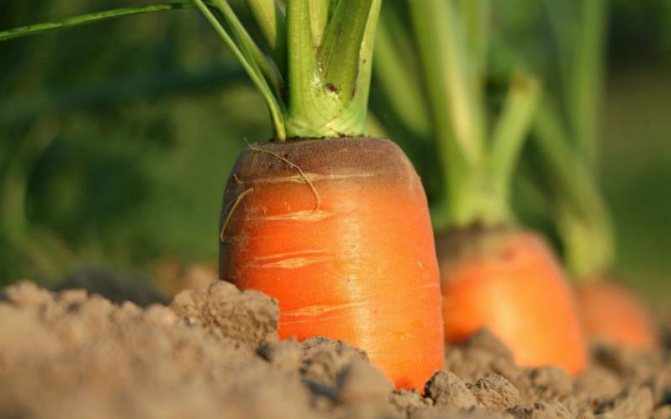

Carrot
Carrot
It is sown at a temperature of 2 ... 40C. The ridge is prepared in advance so that the soil can settle before sowing.
The recommended depth of the sowing material is 3-4 cm.
The width between the ranks is 15-20 cm.
Seeding rate - 1 g / m2.
Carrots are harvested selectively from the beginning of June. The fruits of autumn sowing, in comparison with spring sowing, are worse in storage. Therefore, you need to think about what specific volume will be needed.
Radish
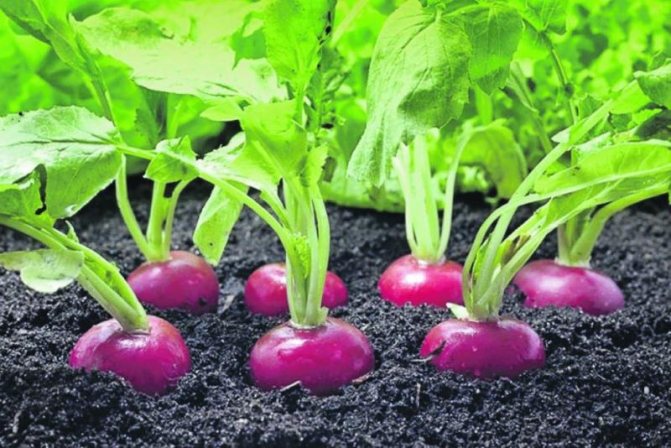

Radish
Radish
Differs in good seed germination even at low temperatures. Therefore, no rush to sowing is necessary. The optimal period is the end of November.
The recommended depth of the sown material is about 3 cm.
Sowing volume - 5-10 g / m2.
Recommended parameters:
| Gap between landings, cm | Width between rows, cm |
| 4-6 | 10-15 |
Turnip
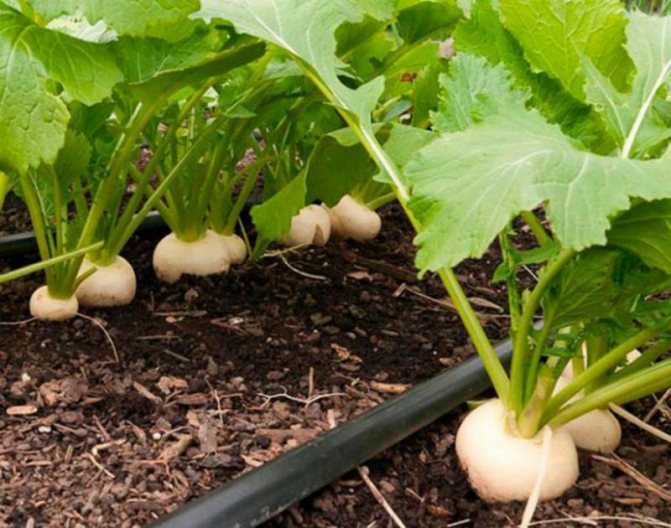

Turnip
Turnip
It is sown before the onset of established frosts in 14 days. This method gives the seed the opportunity for early formation, which saves the culture from the attack of the cruciferous flea.
The recommended depth of the sown material is 3 cm.
Sowing volume - 2 g / m2.
Turnip is planted with 3 seeds in each hole. Sowing fruits before cold weather can be harvested at the end of May.
Recommended parameters:
| Gap between landings, cm | Gap between rows, cm |
| 15 | 25-30 |
Beet
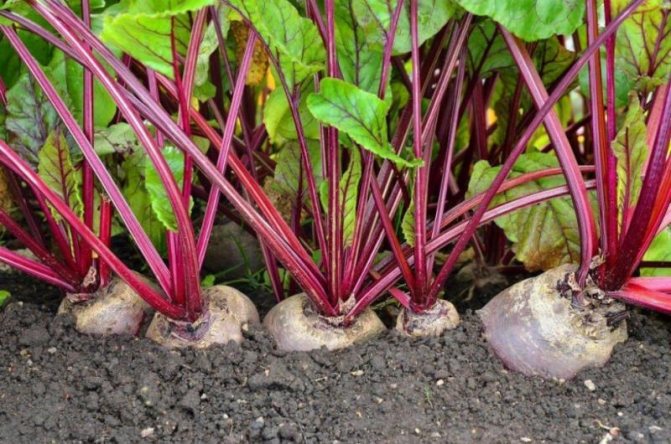

Beet
Beet
Begins to hatch at a temperature of 50C. Therefore, planting in winter should be during the already established cooling (-2 ... -40C).
The recommended seed depth is 3-4 cm.
Seeding rate - 4 g / m2.
The first winter sowing crop is ready to be harvested in early June. Root crops of autumn sowing are poorly stored.
Recommended parameters:
| Gap between landings, cm | Distance between shegengs, cm |
| 5-10 | 20-30 |
Reproduction of pansies
Chrysanthemum,
- Of the other annual crops, you can sow the following types of flowers before winter:Sown before winter
- Planting flowers before winterApical cuttings with 2-3 nodules. From above, they must be covered with a jar or cellophane to maintain high humidity. In the fall, when the cuttings are well rooted and grow back, they can be transplanted to a permanent place.
- Therefore, if you decide to ennoble your summer cottage with beautiful flower beds, do not forget to follow the instructions for a "fertile harvest". Do not be afraid to resort to flower propagation, because there is never too much beauty.Of course, it is necessary to follow the planting recommendations of the variety you have chosen, but if the temperature is quite acceptable for planting in your region, you should not postpone planting.
The first feeding is carried out at the budding stage, and the second already during the flowering period.
The seedlings love to be cool, therefore, immediately after planting, ensure the optimal room temperature in the range of +17 to +20 ° C. As soon as you notice the first shoots, reduce the temperature to +13 - +17 ° C. Feed new flowers during the growing season. To do this, you can use an instant fertilizer containing nitrogen, phosphorus and potassium.
The official name of pansies is viola or tricolor violet.
Foxglove mallow,
Calendula,
Planting annual flowers in boxes and pots before winter
Especially valuable for rare varieties and species when there is a small amount of seeds. This method is more laborious, and is not suitable for those who only occasionally visit the site in autumn (and winter).
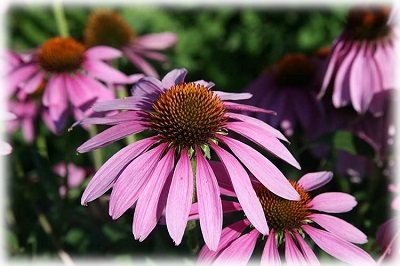

It differs slightly from the first two sowing options, in this case flower seeds germinate in separate containers. For these purposes, shallow pots or boxes with drainage holes up to 10 cm deep are suitable.
A suitable soil mixture is prepared: sand, peat and garden soil. With this mixture, containers are filled (with a pre-poured drainage 2 cm thick), watered well, taken out and dripped in the garden.
It is advisable to cover the top with plastic wrap until the time of disembarkation. When the time comes, the film is removed and the seeds are sown, which are covered with a layer of earth about 2 cm thick. If they are too small, for convenience they can be planted after sprinkling the substrate with sand. On top of the soil, the crops are sprinkled with compost or fallen leaves.
In the spring, the grown seedlings are thinned well, and at the end of spring, the matured plants are transplanted to a permanent place.
What annuals can be grown in this way?
Before planting, you need to figure out the seeds of which flowers can be planted before winter.
All flower crops meet certain requirements:
- resistant to cold;
- do not tolerate any transplants;
- their seeds cannot be stored for a long time;
- have a short growing season;
- their seeds require additional stratification.
Suitable for winter sowing:
- Floral annual crops with small seeds (planted according to the 20x30 cm scheme):
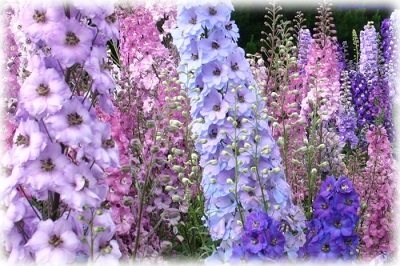

flax (sowing and large-flowered);- lupine;
- nasturtium (curly, terry);
- scabious;
- kosmeya (it must be borne in mind that under unfavorable conditions flowering may come late).
- Floral annual crops with medium-sized seeds (sown according to the scheme 25x25 cm or 25x20 cm):
- Escholzia (Californian);
- matthiola;
- delphinium (annual);
- mignonette;
- carnation (Chinese, hybrid).
- Floral annual crops with small seeds (sown according to the scheme 15x20 cm):
- hop;
- clarkia;
- poppy;
- chrysanthemum maiden.
- Other, often sown before winter, annual flowers:
- asters and chrysanthemums (annuals) - according to the scheme 20x30 cm; feature: crops before winter are often affected by fusarium;
- alissum - according to the scheme 15x15 cm; feature: too dense planting - increased risk of powdery mildew;
- calendula - according to the scheme 25x10 cm, 30x30 cm (depending on the variety); feature: the recommended seeding depth is at least 1 cm;
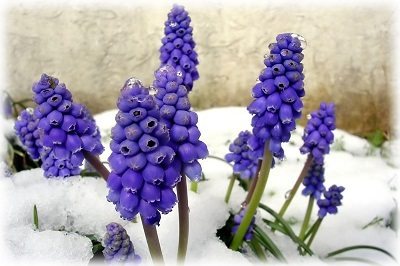

adonis (autumn and summer) - according to the scheme 25x20 cm; feature: seeds have an increased sensitivity to light, stratification is required;- Gaillardia - according to the scheme 30x30 cm; feature: the culture massively produces self-seeding;
- Iberis - according to the scheme 30x15 cm; feature: susceptible to infection by cruciferous fleas;
- godetia - according to the scheme 15x15 cm;
- snapdragon - according to the scheme 20x30 cm; feature: it is recommended to plant in groups;
- marigolds, cornflower, scented tobacco, nigella and others.
Some annuals reproduce by self-seeding under suitable conditions. But you need to remember that in this case, the plants bloom a little later.
Note to gardeners: what flowers can be planted before winter
Similar articles
Rainbow multicolor
Pay attention to this material - Perennials blooming all summer.
Planting tips
There is no more talk about how to grow pansies. But an important issue is their reproduction. There are three possible ways to reproduce here:
Seedlings are planted in the ground in about two months from the day of sowing seeds or diving. It all depends on the variety and their condition at the time of planting.
- herbaceous biennial or annual plant, which is most common in Europe and temperate climatic regions of Asia. It has a thin, brown taproot. The plant can reach a height of 30 cm, sometimes it grows up to 45 cm. The presented type of pansies are often used in folk medicine, due to their excellent medicinal properties.
External description of the plant
Kosmeya (family aster) - an annual plant. The bush is sprawling, rare, reaches a height of 1.0 - 1.5 m. The most widespread in culture is the double-feathered kosmeya with openwork leaves. The inflorescences are simple, with one row of petals (rarely slightly double), 5 - 8 cm in size. The petals of the corolla are painted in white, pink and red tones. Blooms for a long time (from July to October). Faded flowers do not spoil the decorative effect of the plant.
It is used for planting in small tracts, in ridges, mixborders, in groups in combination with decorative deciduous plants.
When to start winter planting
The main rule of winter sowing: do not rush. Don't be afraid to put seeds in frozen ground.
The danger lies in something else: seeds sown too early can germinate from the last autumn heat, and then inevitably die from frost.
The optimal parameters for autumn planting are:
- Soil temperature no more than + 3 + 5оС;
- The air temperature is about zero;
- Up to stable frost no more than two weeks.
On average for the regions, such conditions are:
- from mid to late October in Siberia;
- the end of October - the first decade of November in the Central zone and in the Moscow region;
- November - until the first days of December in the southern regions of Russia.
Sowing flower seeds before winter
The planting site is chosen flat so that in the spring the melt water does not wash the seeds. Before sowing, the beds are freed from the tops of carrion and various plant residues, and they are dug up. Into the ground seeds should be planted thicker than in spring... The germination rate of such seeds is lower, it is difficult for them to break through the soil that has compacted during the winter. After planting, the ground is mulched with a not thick layer of soil mixed with peat or humus, you can cover it with branches on top. The mulching mixture must be prepared in advance.
But even before planting, you need to prepare the land for sowing seeds in the fall, dig in and apply fertilizer. Make shallow grooves in the seedbed until the ground is frozen. When choosing flowers for an autumn garden, do not forget about the requirements of some plants. Basically, unpretentious plants are planted at their summer cottage.
Protecting viola from pests
Amaranth,
... In comparison with the special cultivation of seedlings, I can note the low germination of seeds.However, if I do this planting method annually and only use my seeds, they will adapt over the years. Natural selection will take place, as a result of which new varieties will be developed that are resistant to our winters. Then every year the seedlings will sprout more and more amicably. The plants will all be strong and healthy.
Planting annual and perennial flowers before winter has many advantages. The seeds are well hardened, and in the spring they give high-quality shoots, which are distinguished by good growth, and are resistant to frost and disease.
Viola, with improper care, may develop such diseases as black leg, stem and root rot, downy mildew, leaf spot, aphids. However, all this can be safely avoided if water is not allowed to stagnate at the plant roots.
Rate this article: Planting and caring for pansies (violet tricolor) .5.00 / 5 votes - 2
TOP-8 of the most suitable plants and their best varieties | Testimonials
In winter, you can calmly rest and gain strength before the next tiring season. After all, there is so much work in the spring: planting vegetables and herbs, caring for them, watering and fertilizing. But for some gardeners this is not so scary, because they have already done part of the work, namely, they planted something in the fall.
What is this for? For a good harvest. It will ripen much earlier in time. And what kind of vegetables can be planted before winter, you can study in our article.
Description
The second name for nasturtium is capuchin. These herbaceous crops belong to the nasturtium family.
In nature, there are up to 90 varieties of them. The countries of South America are considered the homeland of the plant, but this flower can also be successfully grown in our country.
It has a beautiful appearance, has a long flowering. The culture received the name capuchin for the shape of the inflorescence, which vaguely resembles a hood.
Note: there are differences between the varieties of nasturtium. Some plants spread along the surface of the earth, others grow in the form of dwarf shrubs.
The leaves of nasturtium are lobed, the inflorescences consist of five double or semi-double petals. The color of the flowers is yellow, but it can also be red.
The fruits are divided into three kidney-shaped parts with several seeds. Nasturtium is used not only for decorating the garden area, but also successfully used in cooking and in folk medicine.
Hello dear readers!
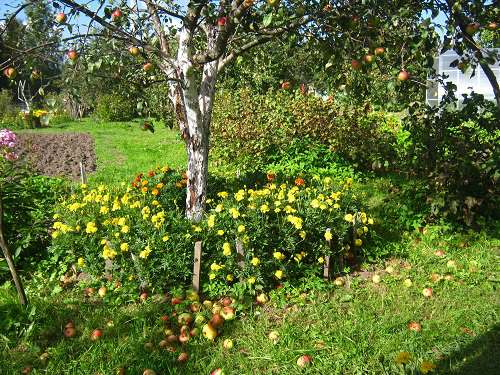

A busy summer has passed, the harvest has been reaped, gardening work has been practically completed. A restless and beautiful autumn has quietly crept up.
It's time to start the next season, so that in the spring you can enjoy the first gifts of our garden. After all, every summer resident knows how there is not enough free time in spring - every hour is expensive.
So why don't we make spring work easier for us and spend sowing before winter our favorite vegetables and flowers.
- Sowing before winter suitable for cold-resistant crops. These are those plants whose leaves do not have pubescence (the edge of the leaves protects the plants from the heat).
If these species are planted in the spring, they will sprout after a month.
Thanks to podzimnuyu sowing, we gain time - the shoots of our winter-hardy vegetables will appear earlier (about 2-3 weeks), which means the harvest too.
Seeds planted in autumn will undergo winter hardening and vegetables grown from them will tolerate frost better.
Seed collection
Cosme seeds ripen well. Germination is maintained for 2-3 years. Outwardly, they look like small skewers. Collecting them is easy. They start harvesting in late August and early September. Ripening, the seeds darken and fan out in different directions, easily crumble into the palm of your hand when touched. Store seeds in a dry and warm place in cloth or paper bags.
It should be noted that the plant is cross-pollinated. This is a feature of representatives of Compositae.Therefore, next year, the new bushes may not completely retain the characteristics of the variety, for example, a new color of inflorescences will appear, the doubleness and shape of the petals will change.
Propagation of cosmos by seeds
Seeds, about one centimeter in size, oblong, dark brown, gray, gray-yellow. A bit like claws. Two hundred and fifty seeds weigh only one gram. Do not lose germination for two years. To avoid cross-pollination, different varieties are planted separately at a distance of up to 500 m.
Without separate cultivation of different varieties in the next season, all kinds of unexpected colors of flowers can appear. It is better to buy varietal seeds from trusted firms to guarantee purity.
Kosmeya reproduces well by itself, giving self-seeding, and can become a weed on the site. The seeds ripen in August. The collection is carried out every week. Collect them at the moment of brown coloration.
Note! When sowing, the seeds are not covered with earth, since seedlings appear only in the light.
Care features
Daisies are highly regarded by landscape designers not only for their extraordinary beauty, but also for their endurance and ease of care. These miniature flowers are considered unpretentious plants, so the peculiarities of planting and caring for daisies in the open field will be within the power of even a novice gardener.
Watering
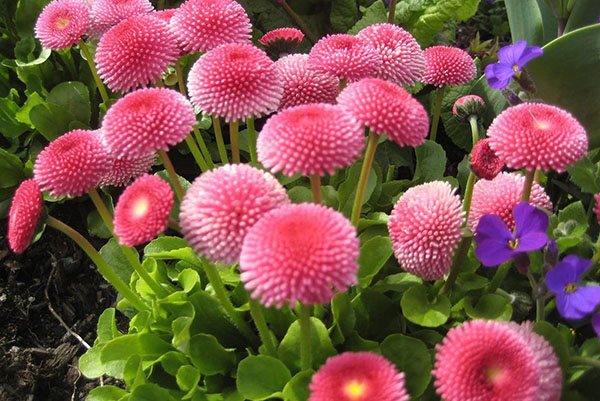

Daisies need regular, abundant watering. If irrigation of the soil is irregular, especially in the hot season, then the flowers of daisies will become small and lose their splendor and velvety. After each watering, the soil should be loosened.
Top dressing
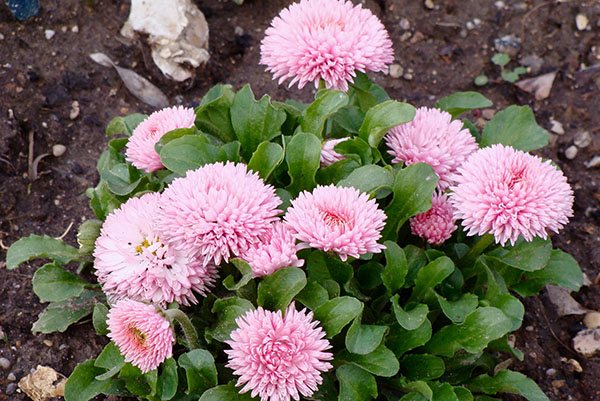

In order for daisies to delight with their lush flowering, they must be fed twice a season. Complex fertilizer for flowering plants is suitable for feeding.
Disease and Pest Control
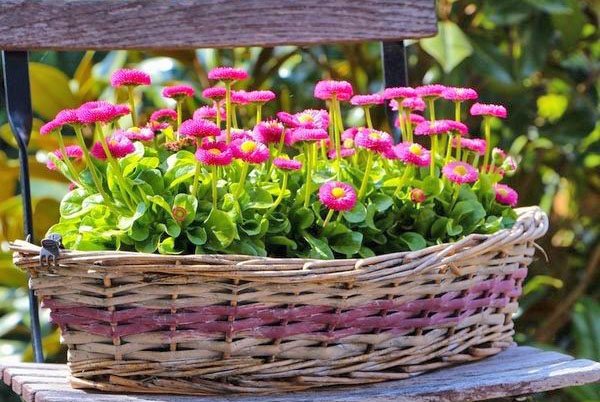

Daisies rarely get sick and are exposed to pests. However, sometimes there are cases of flower disease with powdery mildew or damage by caterpillars and mites.
The following factors can be the causes of plant diseases:
- insufficient or excessive watering of daisies;
- the introduction of excess fertilizers;
- a sharp drop in day and night temperatures.
In case of illness, diseased specimens are removed, and healthy plants are treated with special solutions.
Preparing daisies for winter
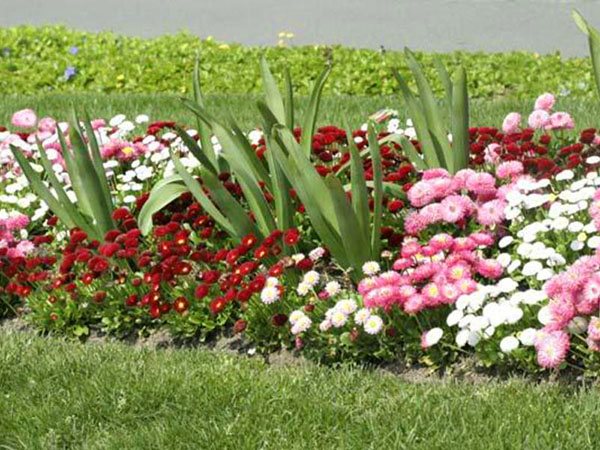

Planting and caring for daisies outdoors in the fall involves preparing the plants for the cold winter. After all, winter is a serious test for all colors. Therefore, in order to protect the flowers from frost, the soil is most often mulched. The need for this procedure increases if the root system is exposed in plants. As a rule, shelter for the winter of daisies in the open field is carried out using sawdust, peat or humus.
The thickness of the soil mulching layer for daisies should not exceed 7 cm.
Unpretentious in the care and cultivation of daisies can become a unique decoration of even the most sophisticated landscape design. Frost-resistant and incredibly beautiful, they are suitable for decorating flower beds and reservoirs. And compliance with the basic rules for planting daisies in open ground and caring for them, even for inexperienced gardeners, will allow you to grow beautiful flowers in a flower bed and enjoy their lush flowering throughout the season.
The most interesting about the daisy - video
—Links
—Applications
- Postcards
Reborn catalog of postcards for all occasions - Online game "Big Farm"
Uncle George left his farm for you, but unfortunately it is not in very good condition. But thanks to your business acumen and the help of neighbors, friends and family, you are able to turn a decayed landlord - Rating buttons "Yandex.blogs"
Adds Yandex rating buttons to the profile. Plus, the charts of the rating change for the month will appear soon. - Always at hand
no analogues ^ _ ^ Allows to insert a panel with arbitrary Html-code into the profile.You can place banners, counters, etc. there - Planting flowers before winter
Planting annual and perennial flowers before winter has many advantages. The seeds are well hardened, and in the spring they give high-quality shoots that are distinguished by good growth and are resistant to frost and disease.
Time is fleeting, only it was spring, and you look already and autumn is just around the corner. Before you can look back, it's October, rainy November, and there are frosts and winter. Everything in the dacha freezes until the new spring, and garden work, it would seem, has long been stopped. But it seems so only at first glance.
In the fall and even early winter, flower seeds can be sown. Planting before winter has many advantages over spring sowing. If you have never experienced this, I advise you to take a closer look at the idea.
It only seems to us that flower seeds are defenseless, and are destroyed by frost. They contain a program of adaptation to any conditions, and germination in any humid well, as soon as the earth warms up enough from the spring sun.

